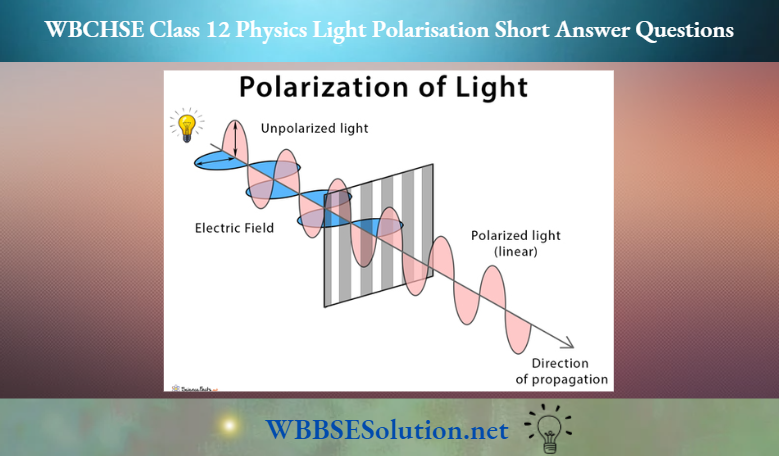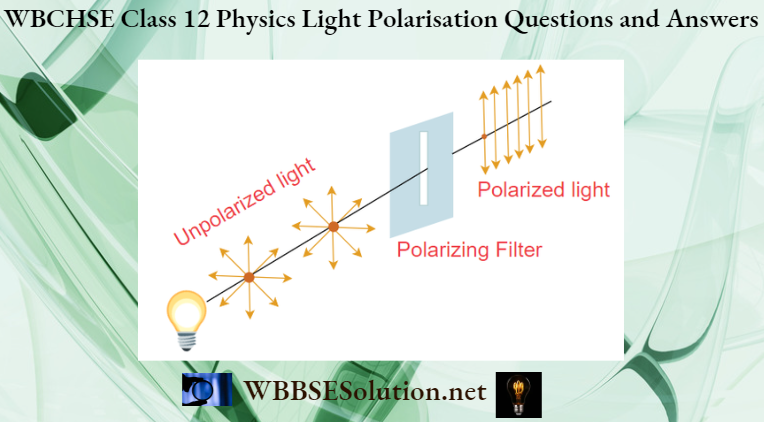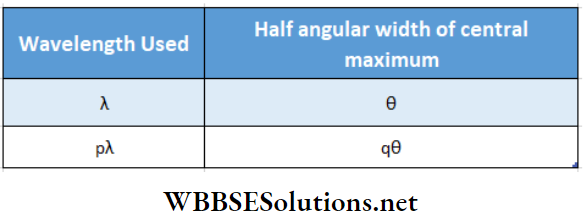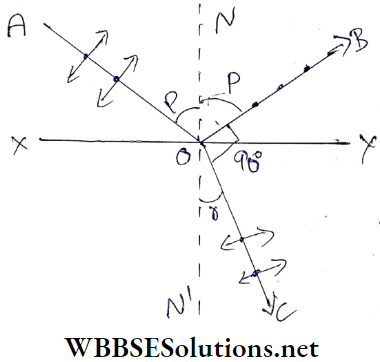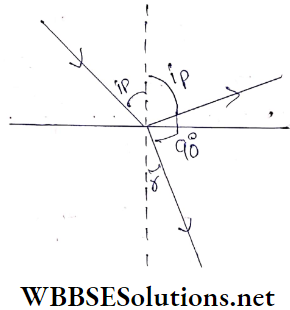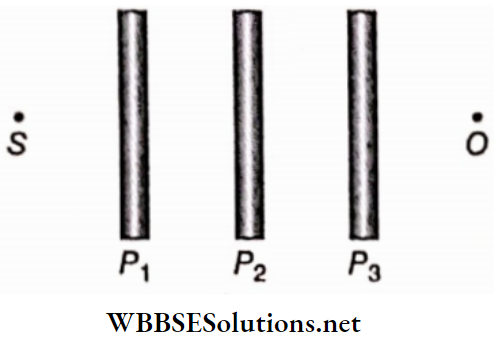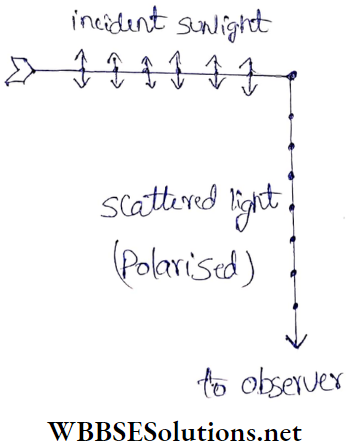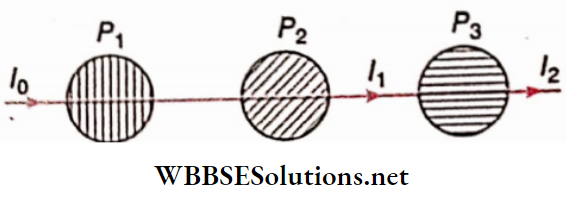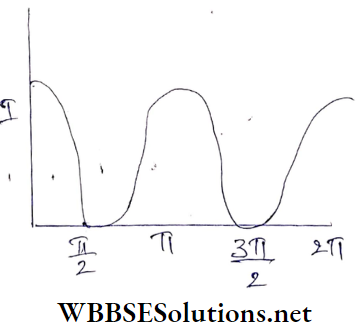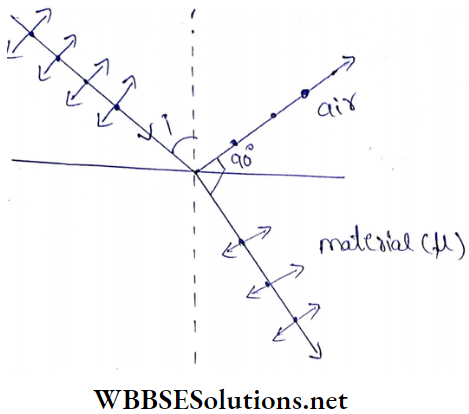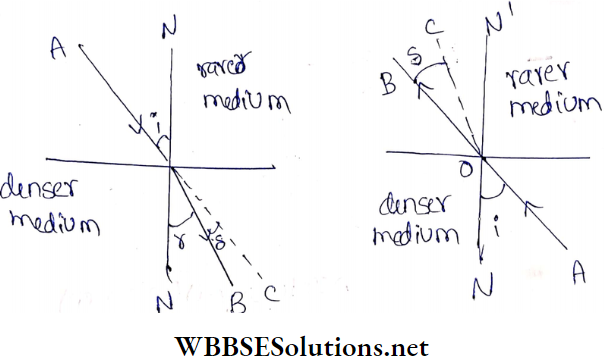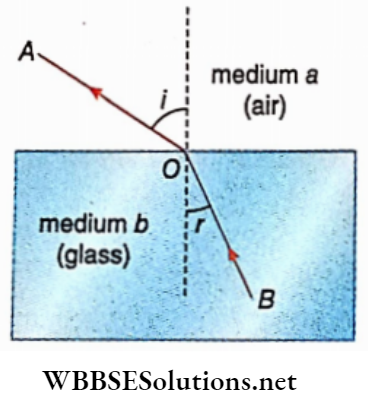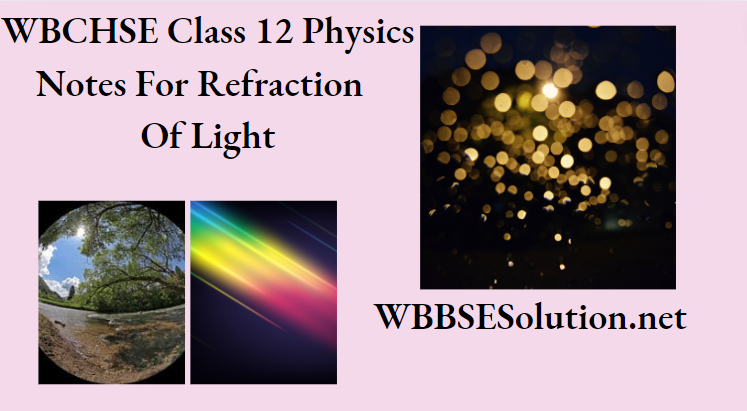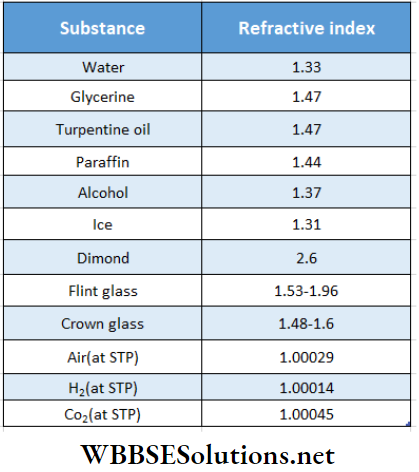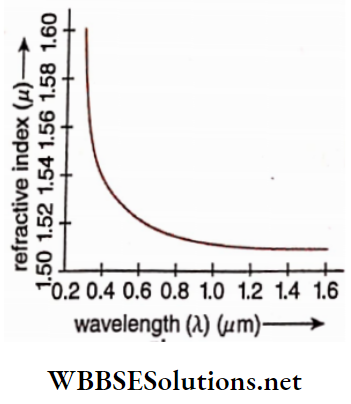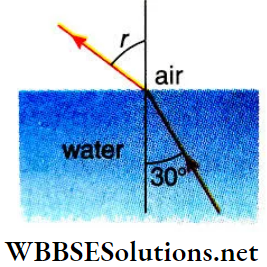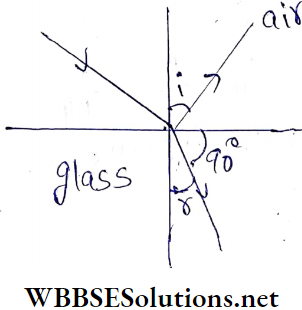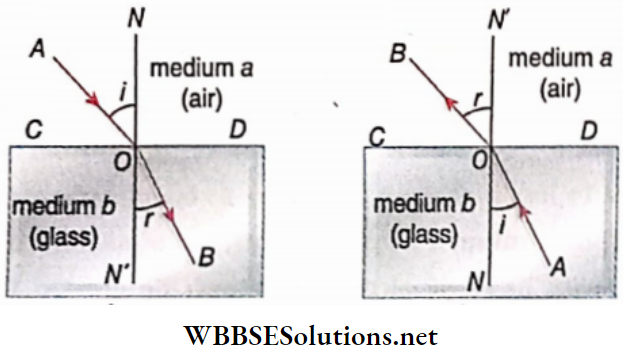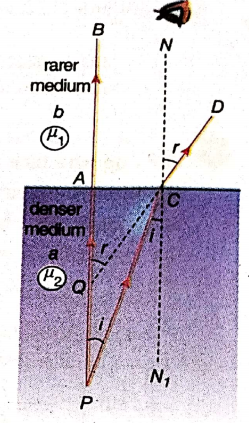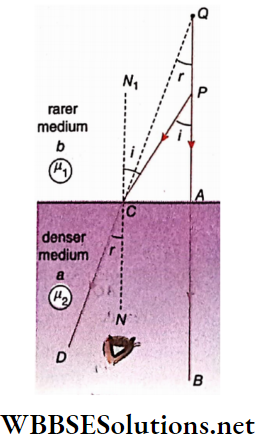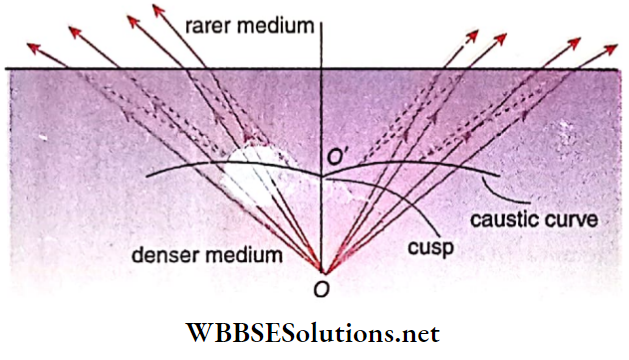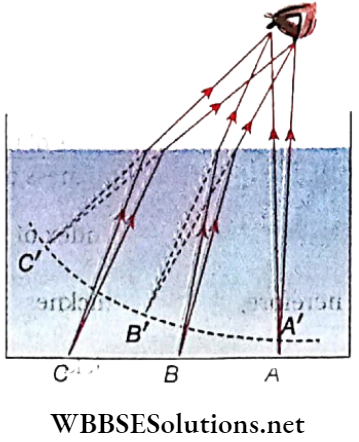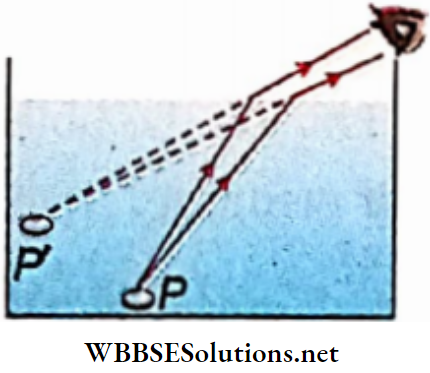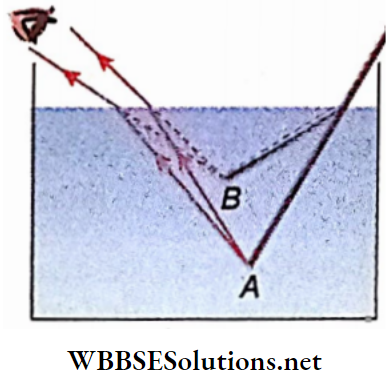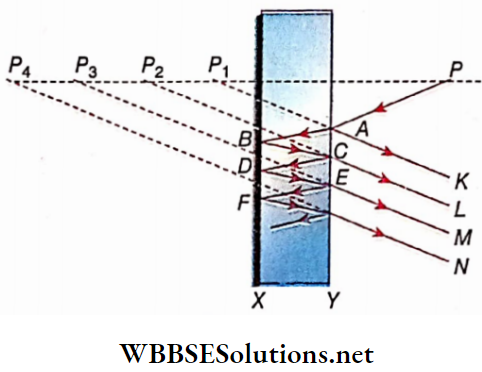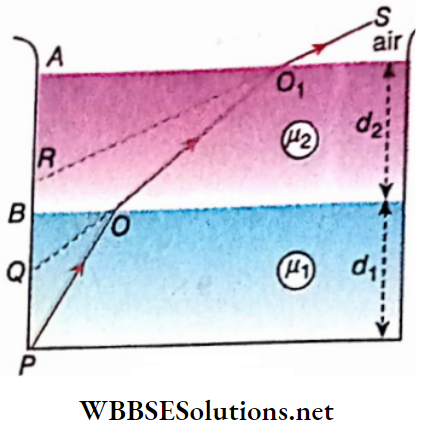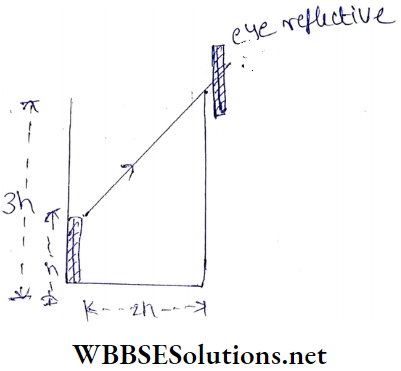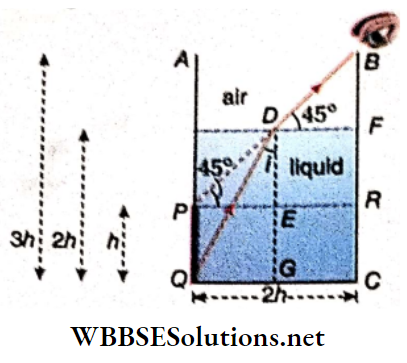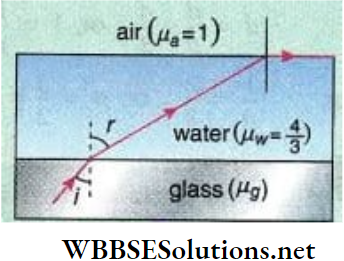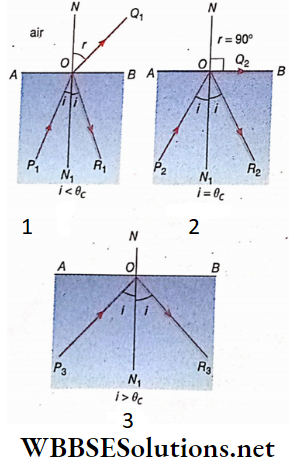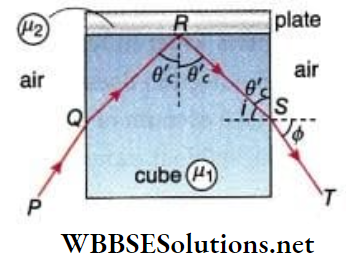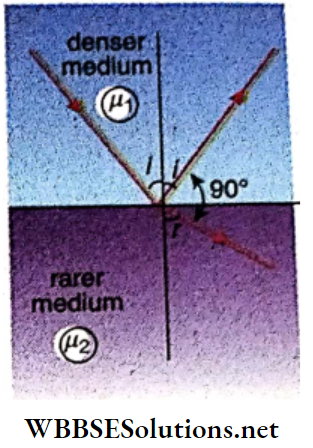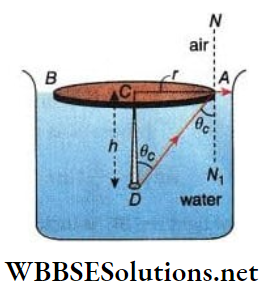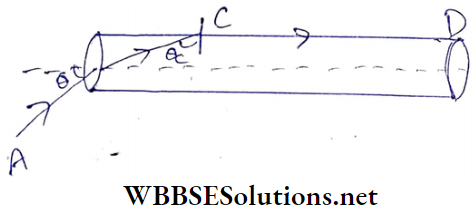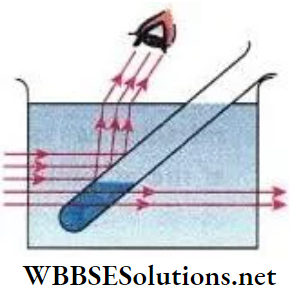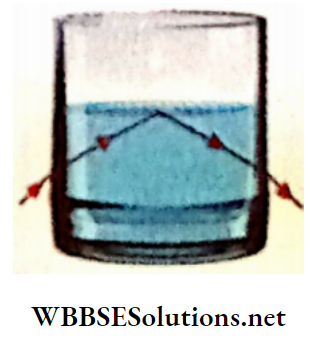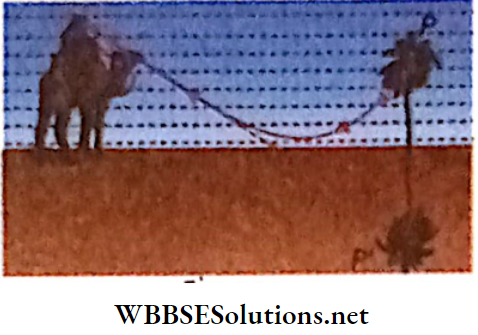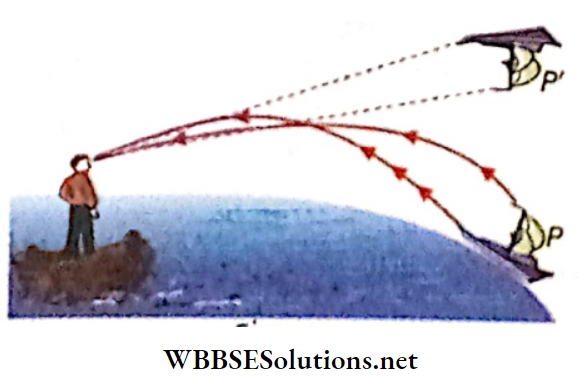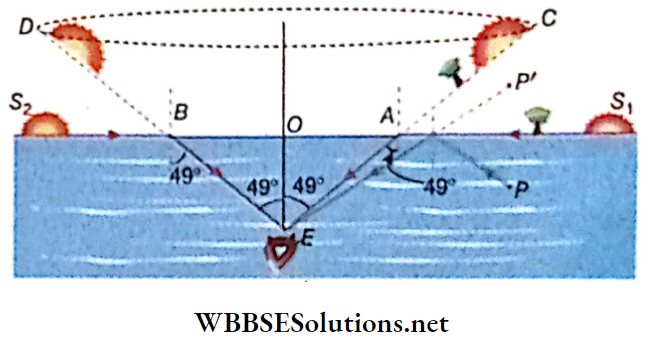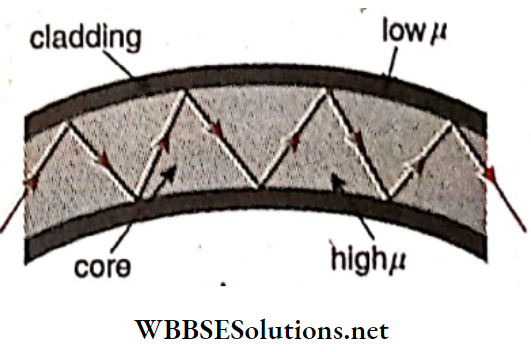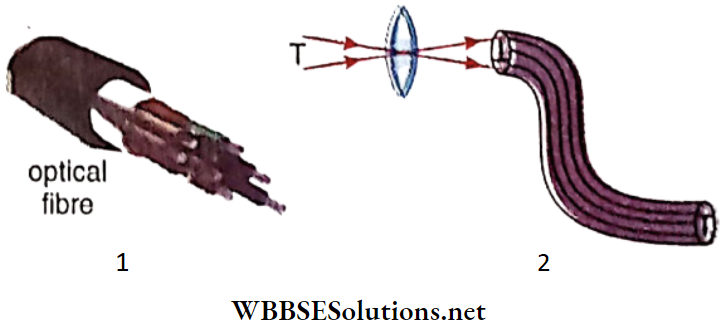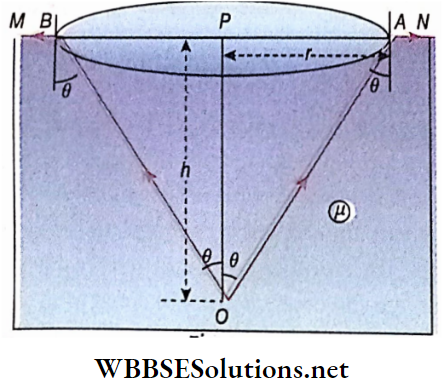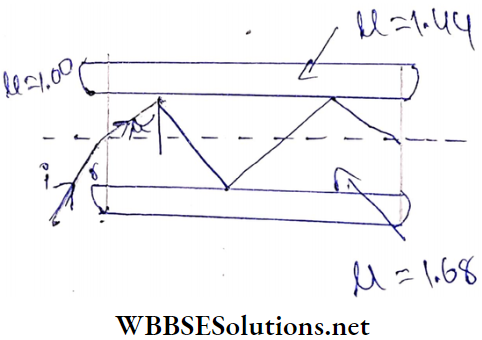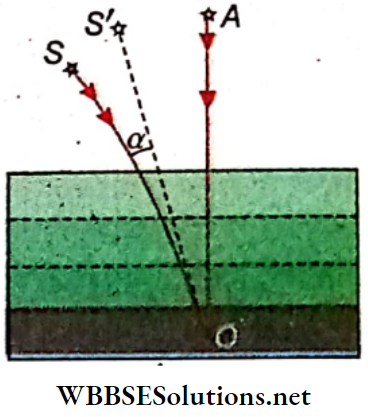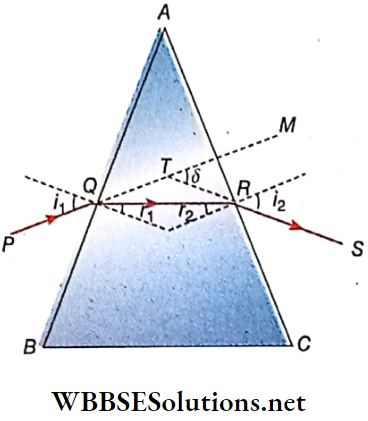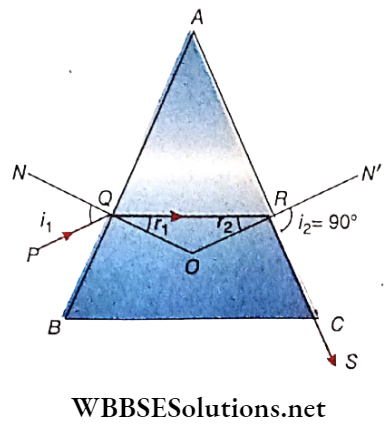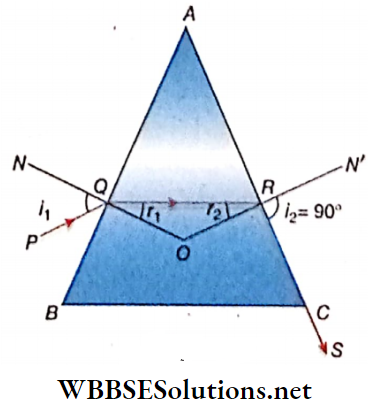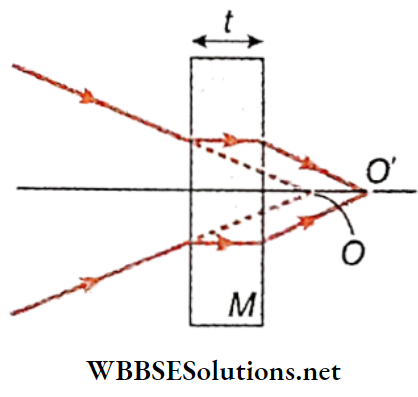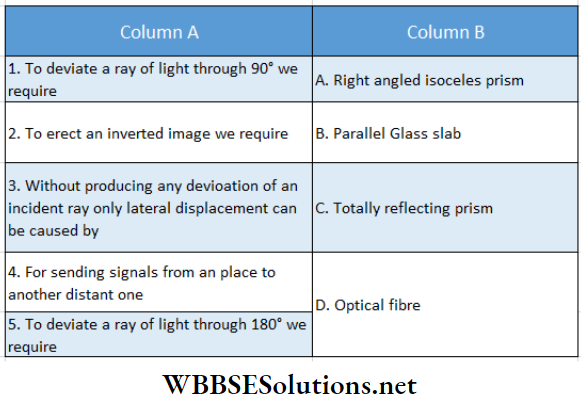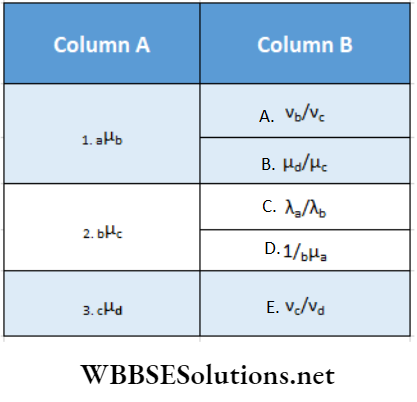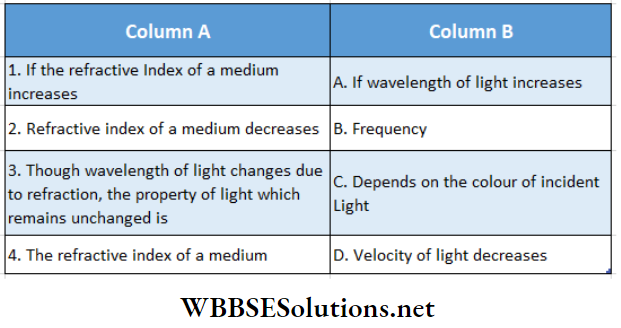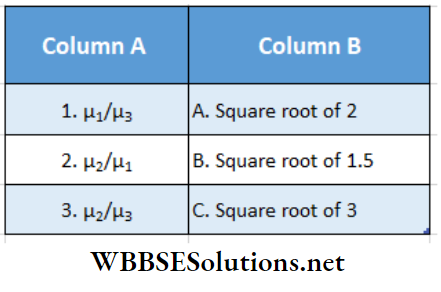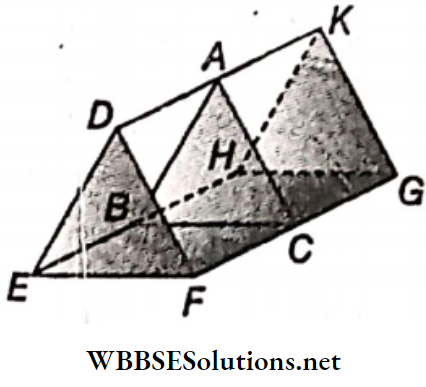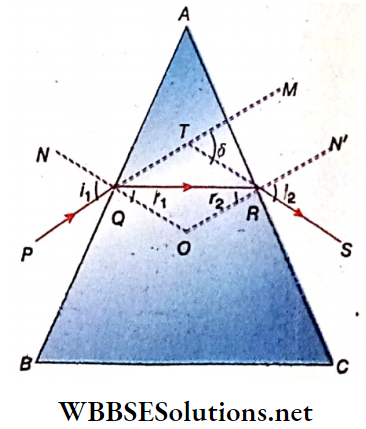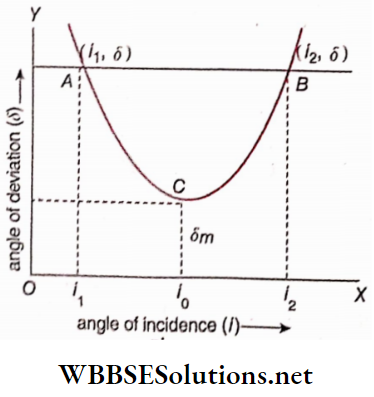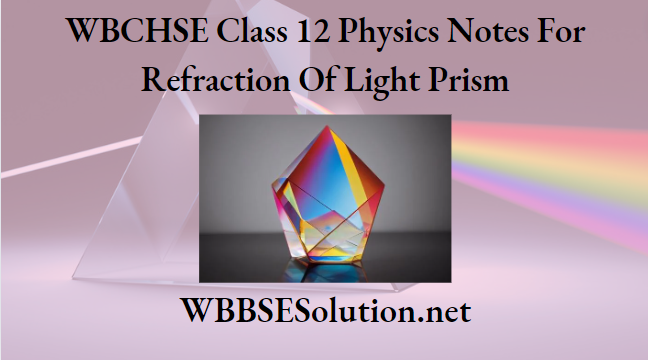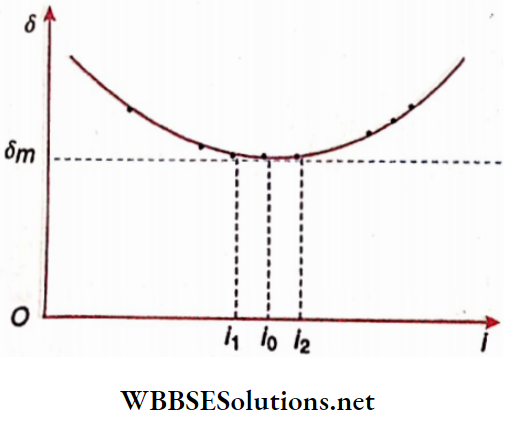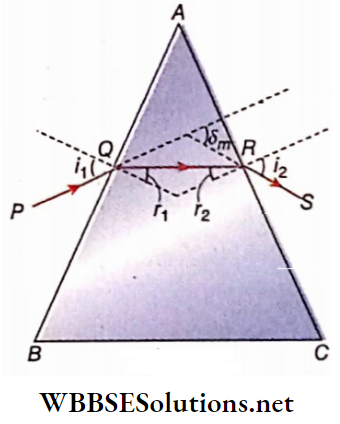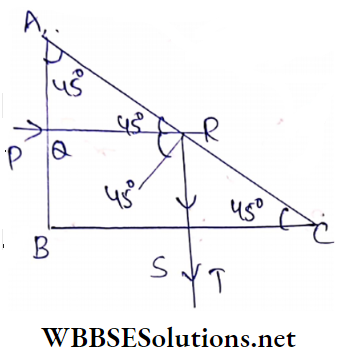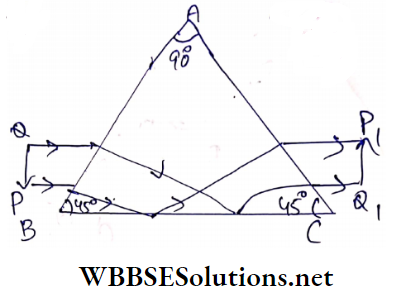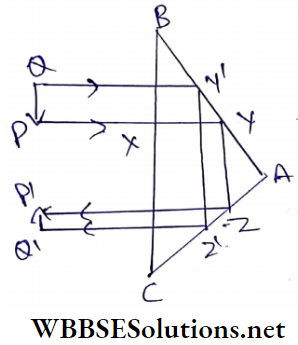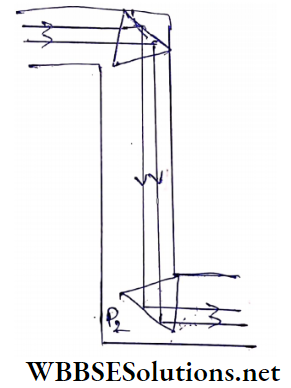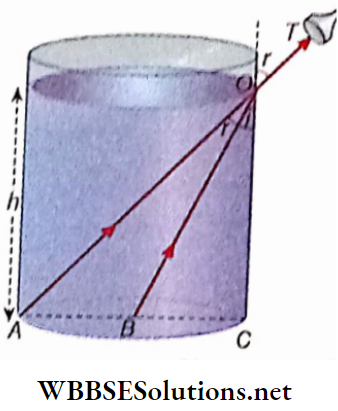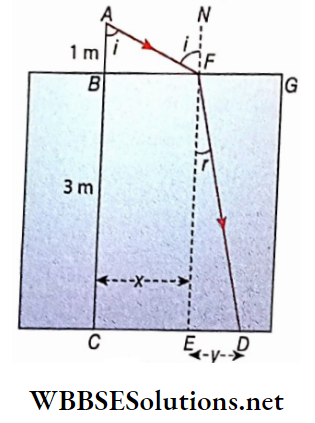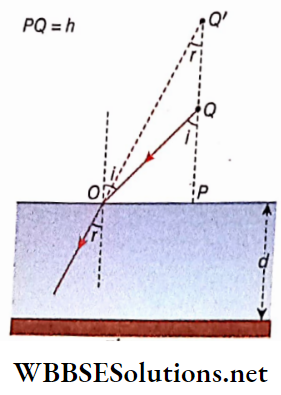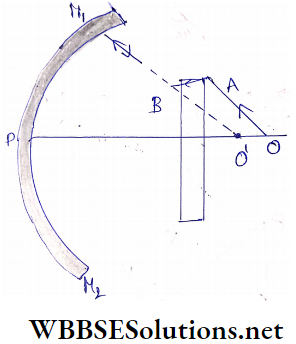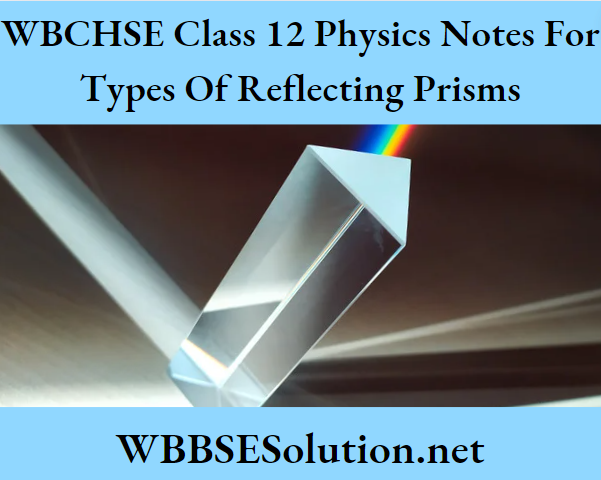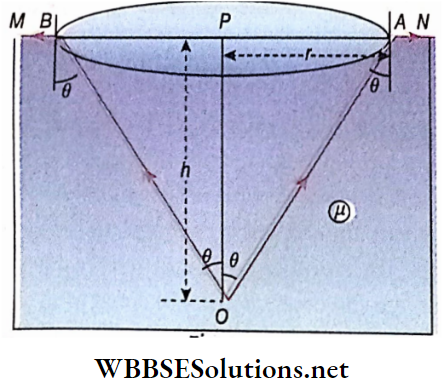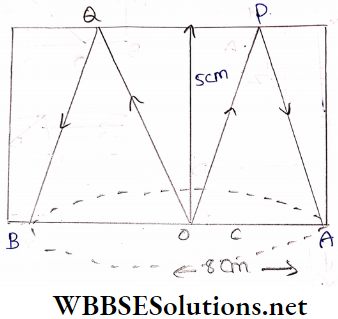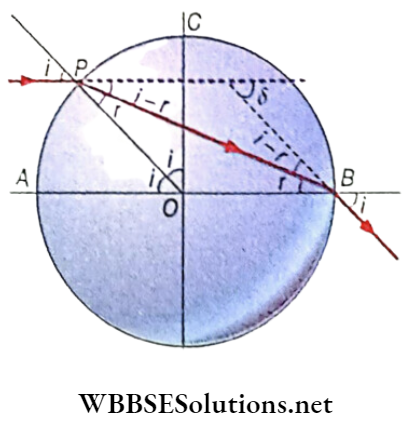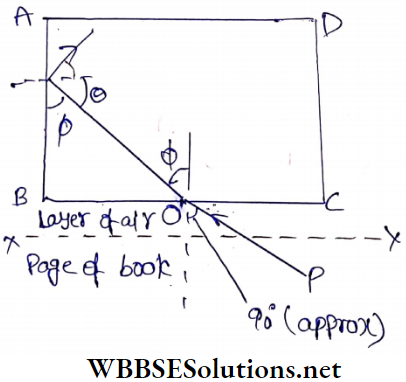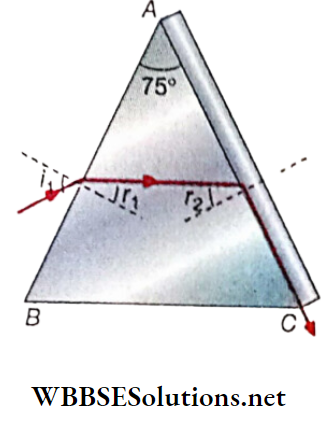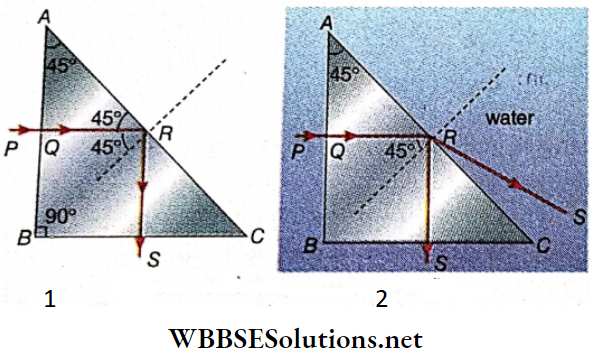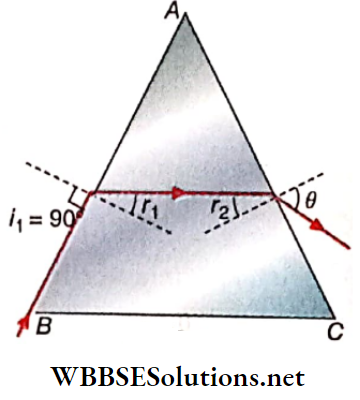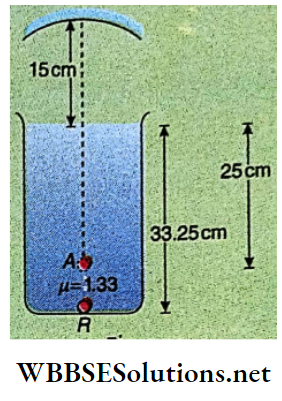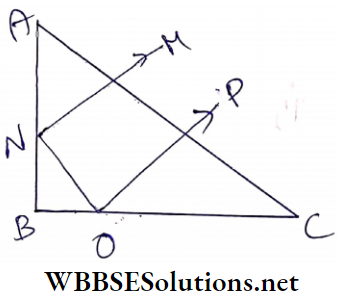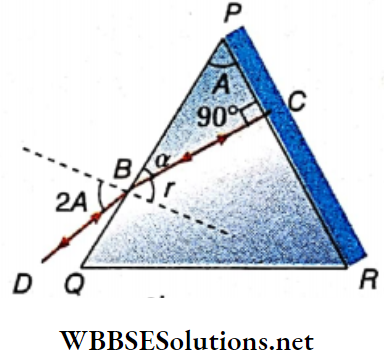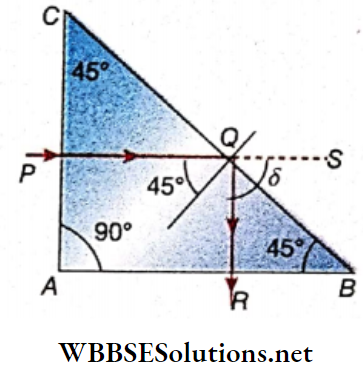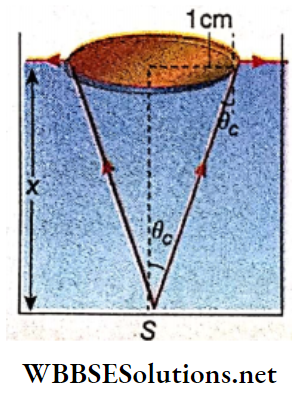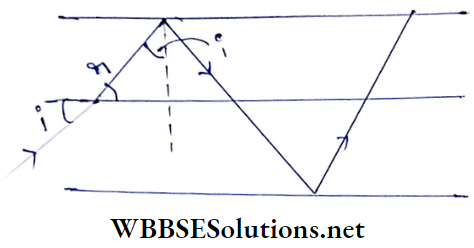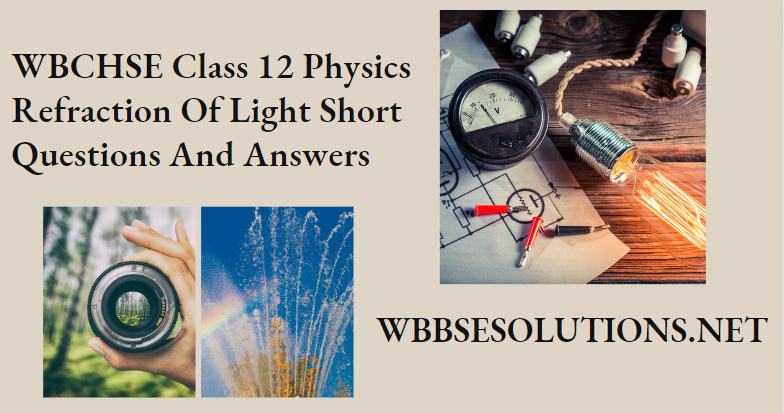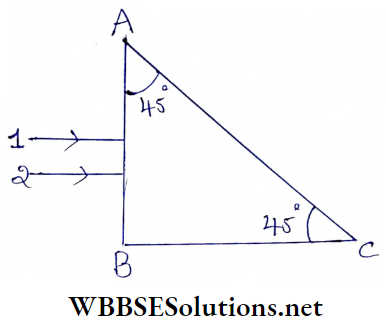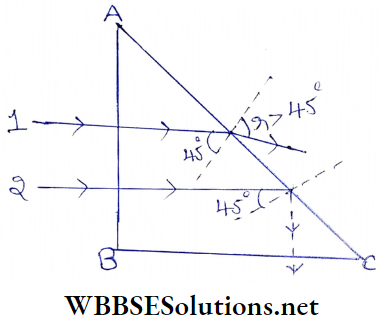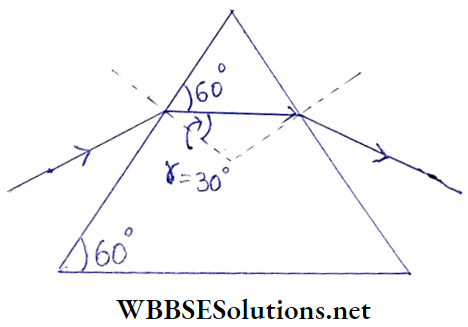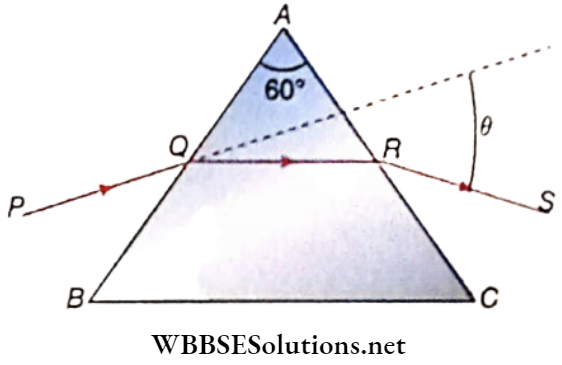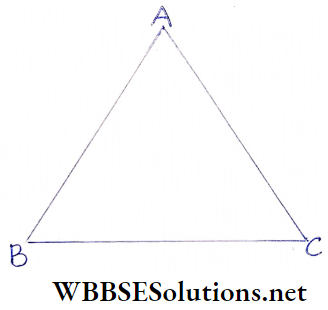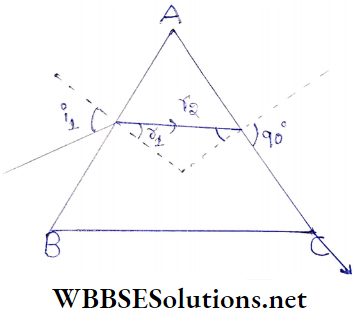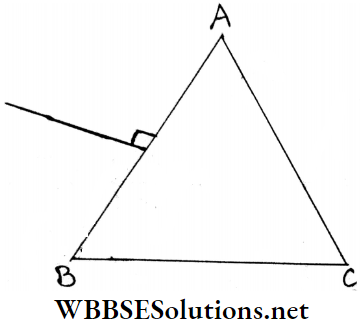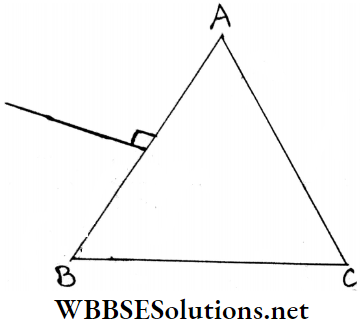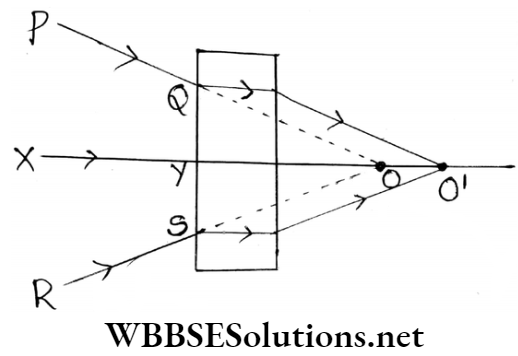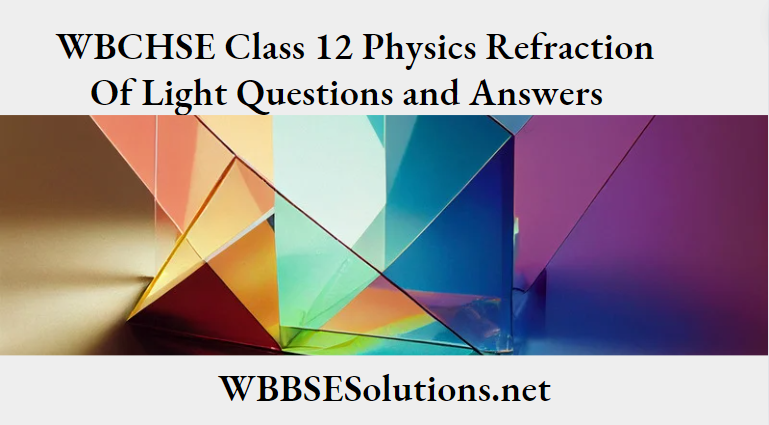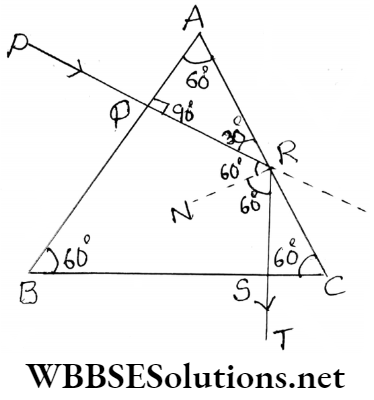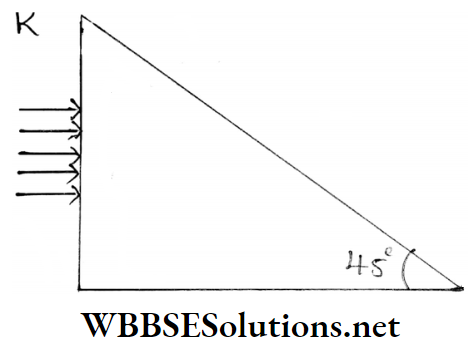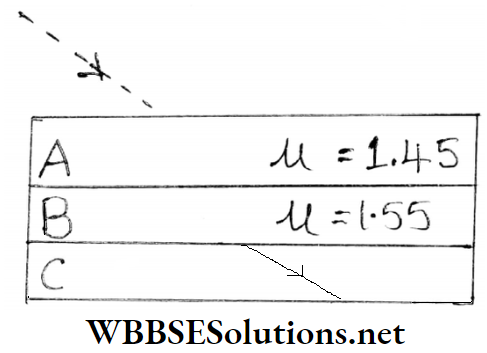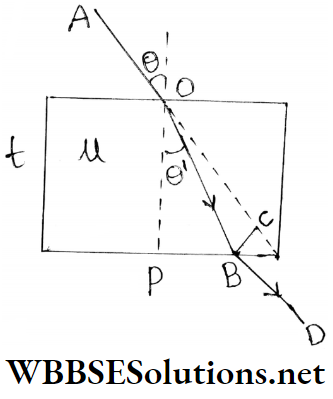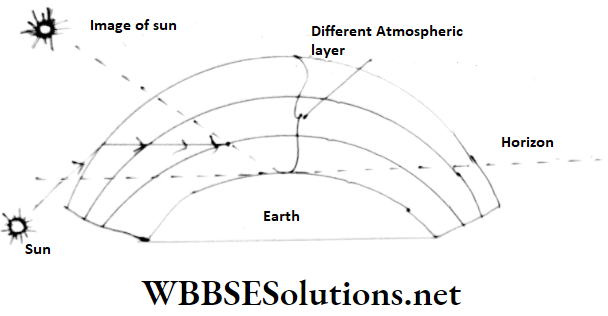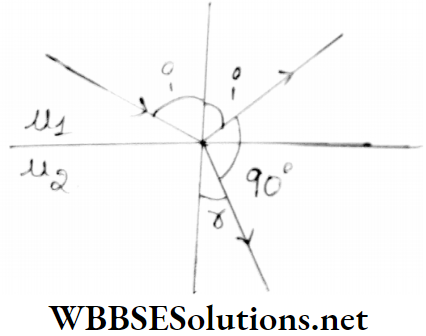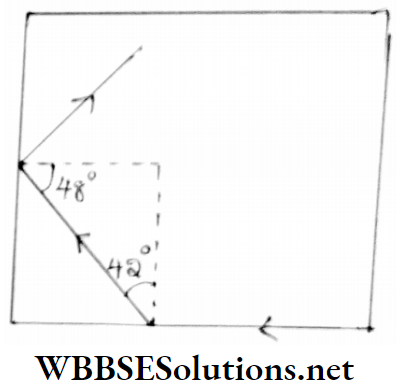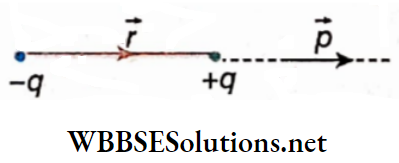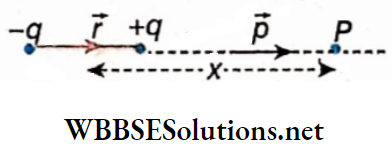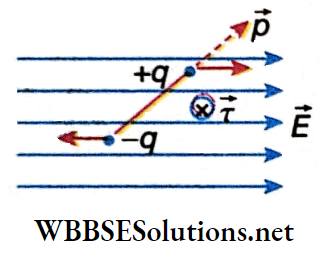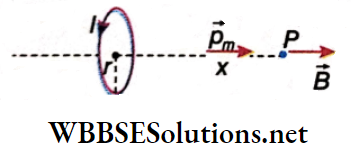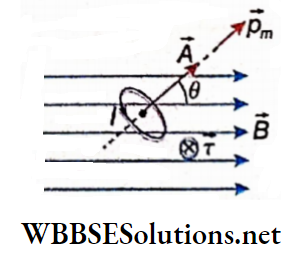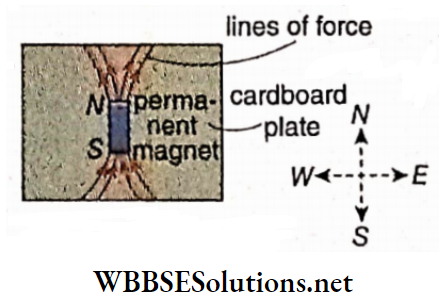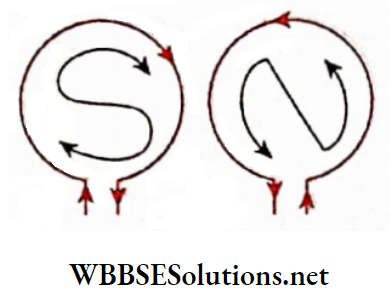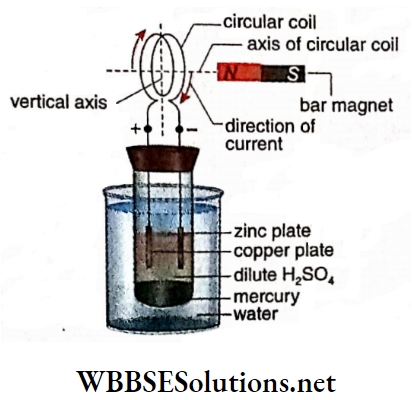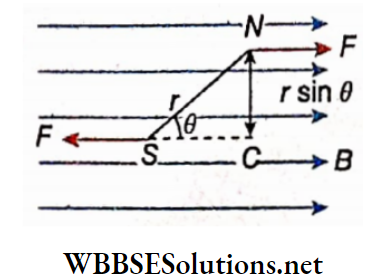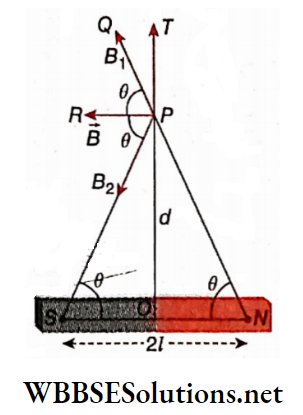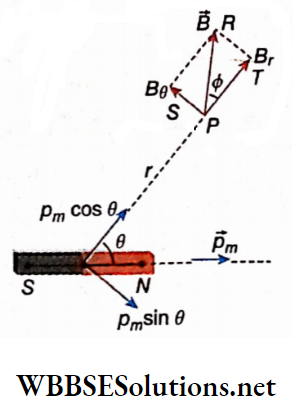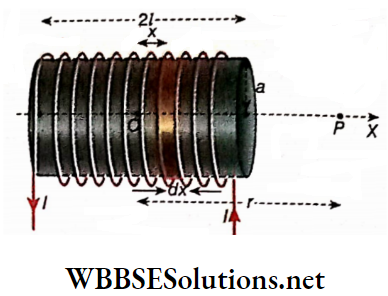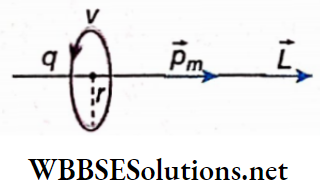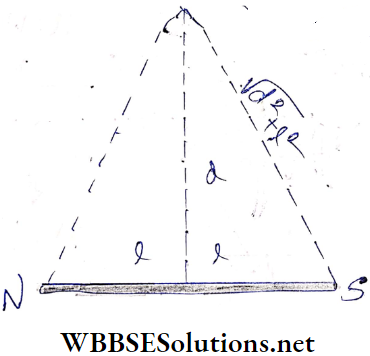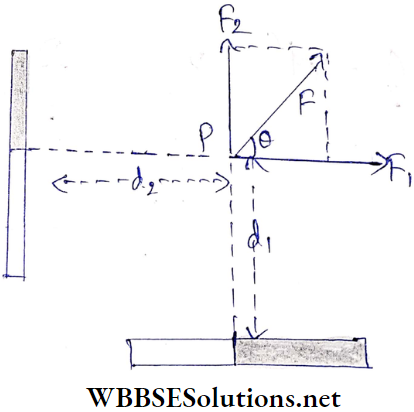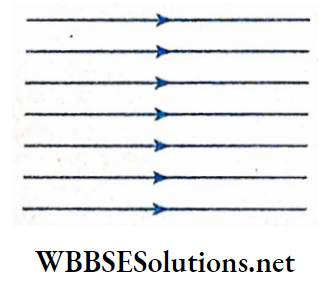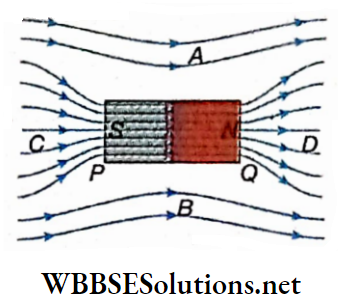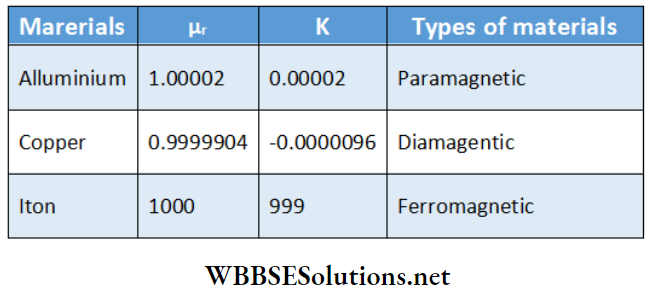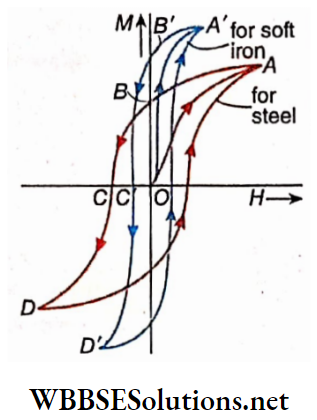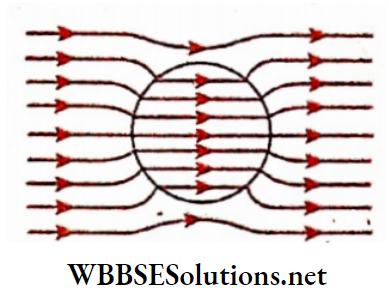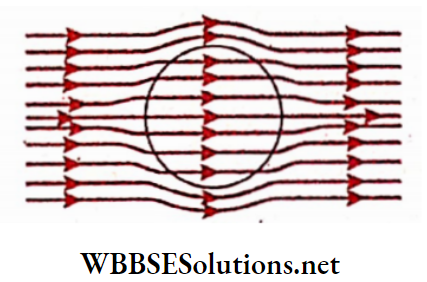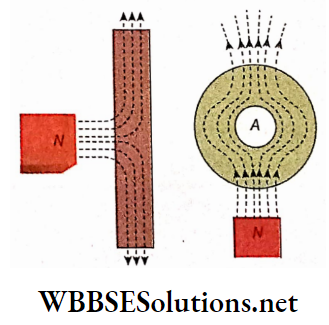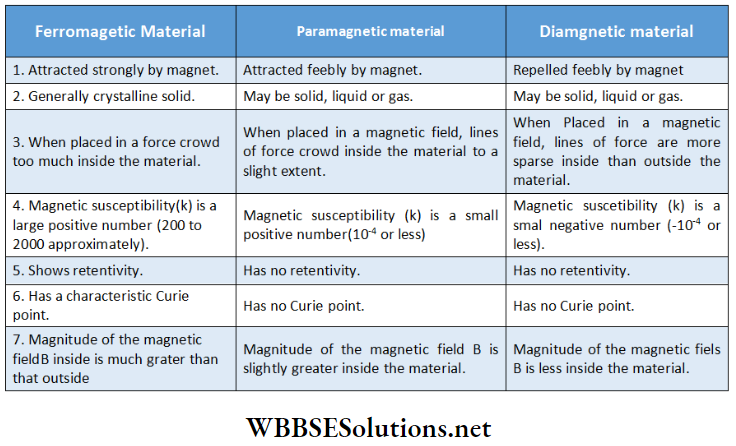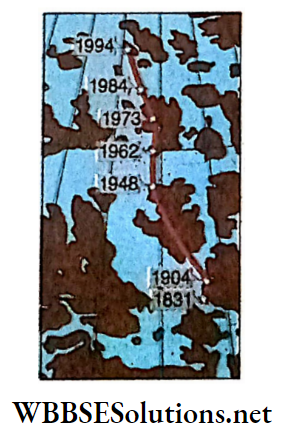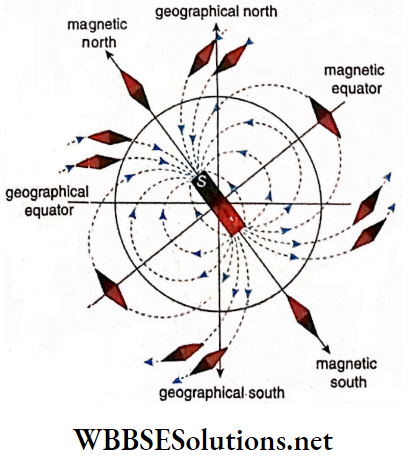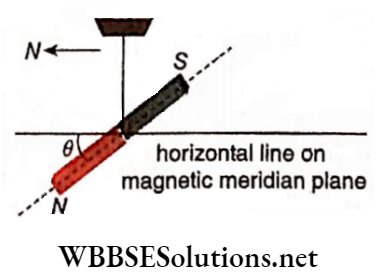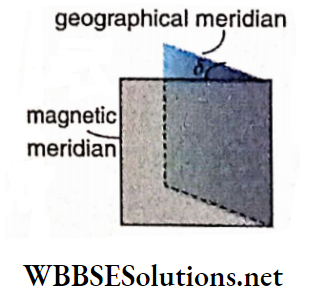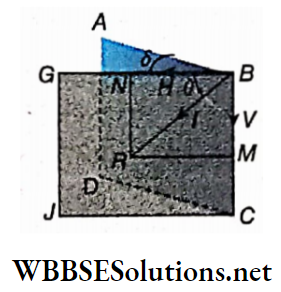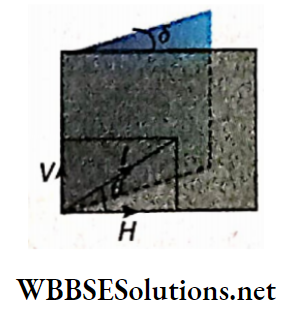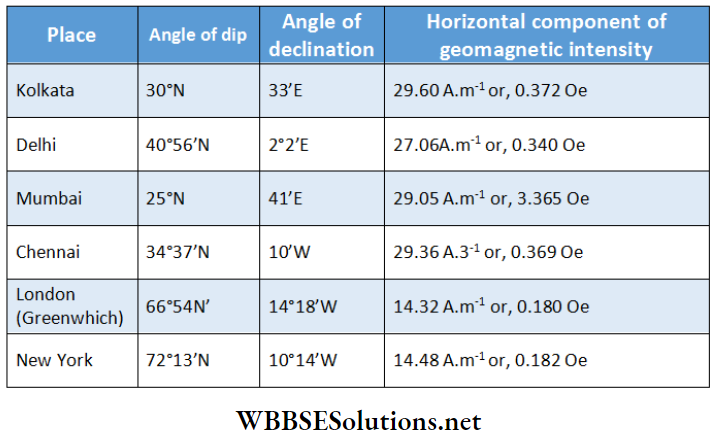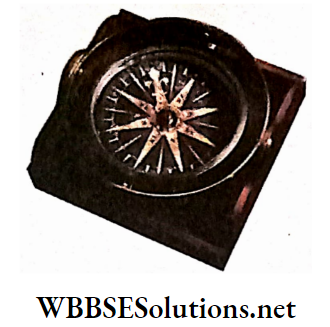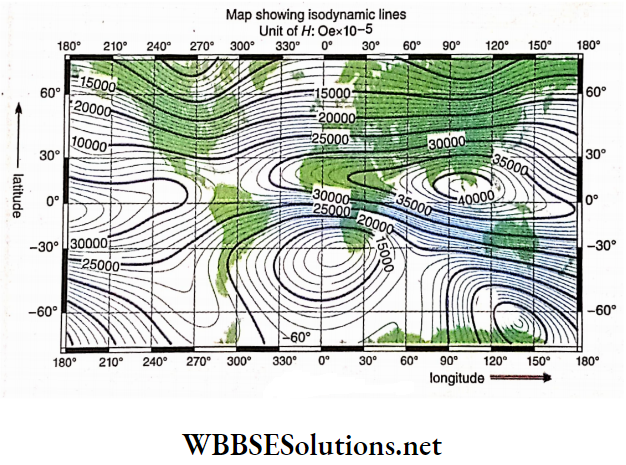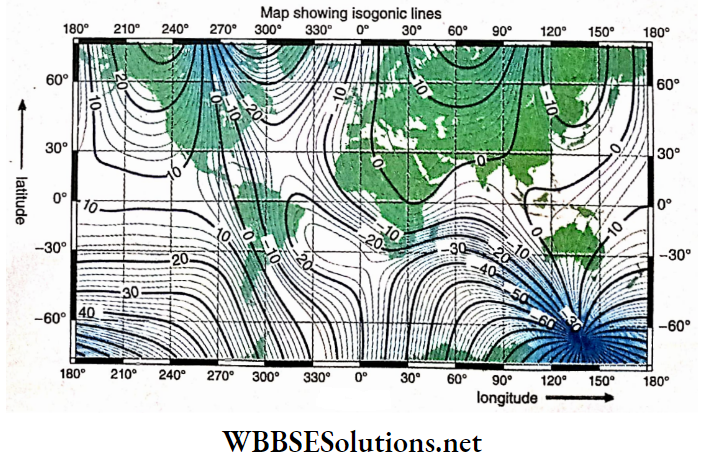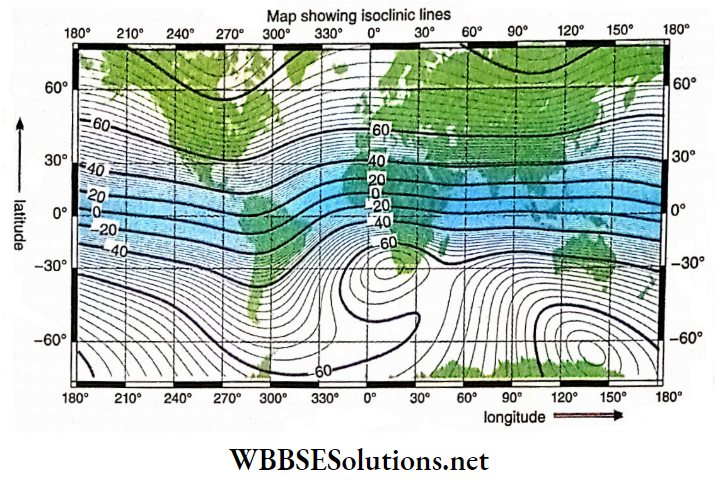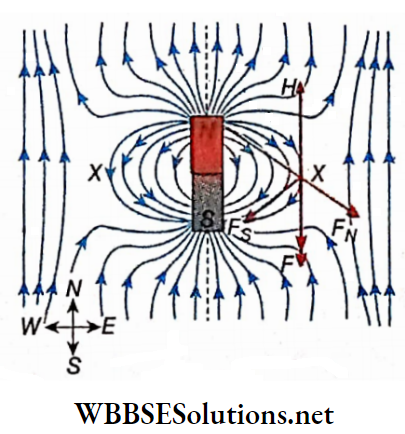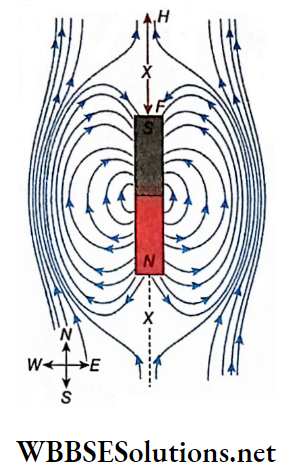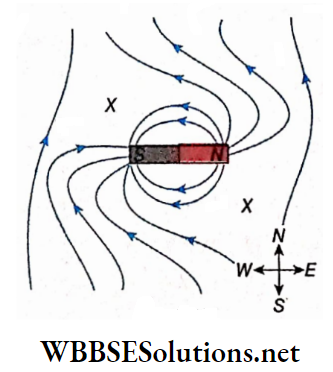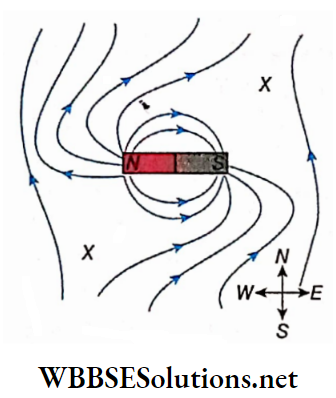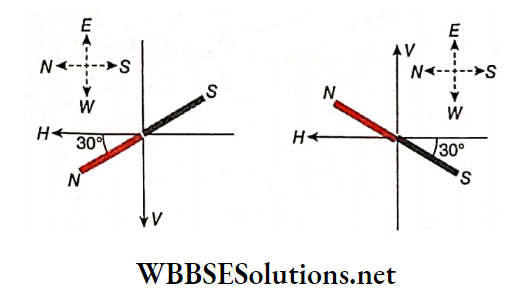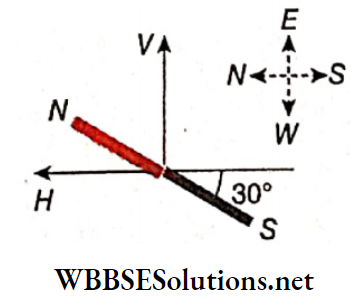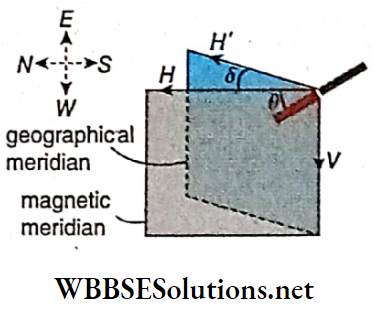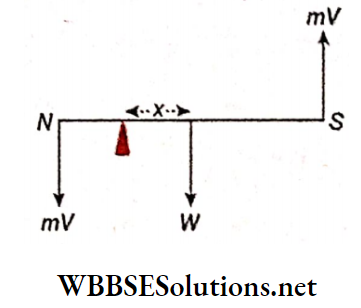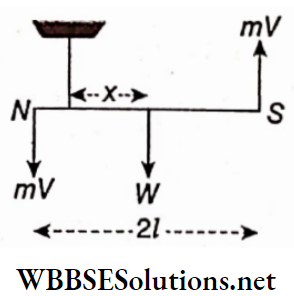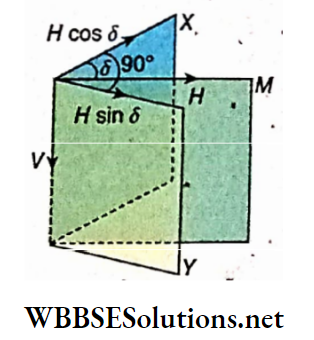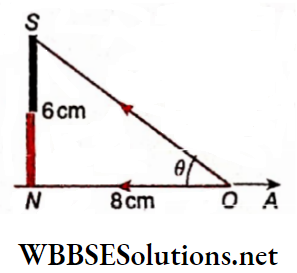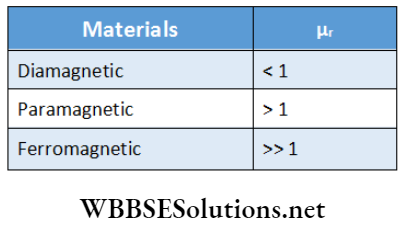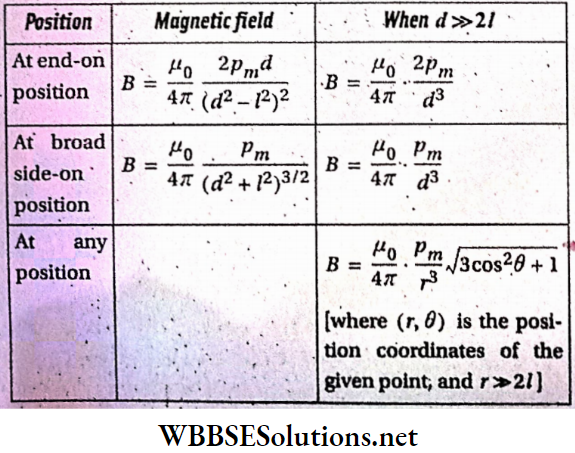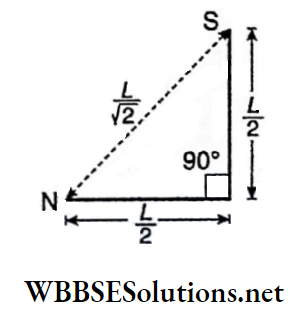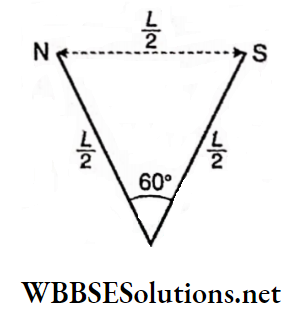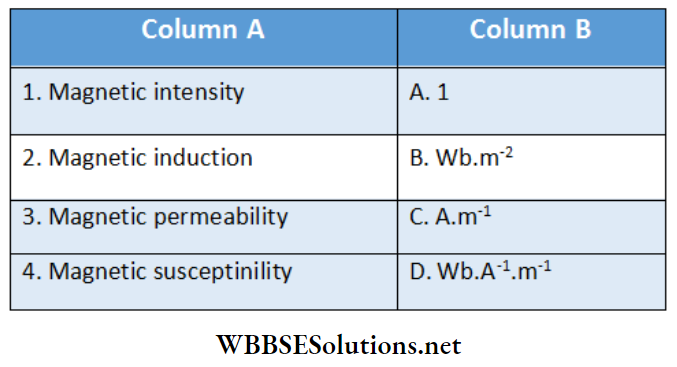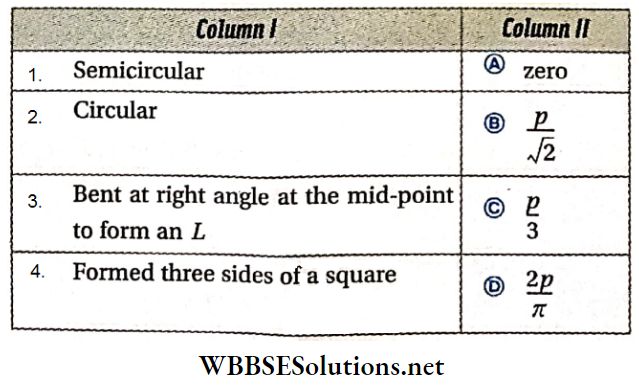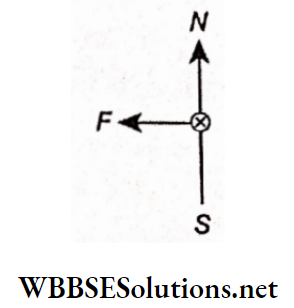Optics
Diffraction And Polarisation Of Light
Diffraction And Polarisation Of Light Definition:
Light rays, while passing round the edges of an A obstacle or aperture, instead of traveling in a straight line, bend to some extent. This phenomenon is known as the diffraction of light.
We know from our daily experience that sound wave bends while passing round the edges of an obstacle or spreads in all directions while passing through a slit or aperture. The same thing happens with light waves. A thin tin sheet placed in sunlight casts its shadow on a wall. Sunrays can be treated as parallel rays and according to geometrical optics, they travel in a straight line. So, a sharp shadow of the thin tin sheet should be observed on the wall.
But if the shadow is examined carefully, it will be seen that the edges are not very distinct. The direction of the light wave changes while passing through the edges of an obstacle or through an aperture. This is called ‘diffraction’ oflight
Read and Learn More Class 12 Physics Notes
In point of In a blade, formed by diffraction monochromatic pattern, mm formed just outside the shadow of the blade, is shown in an enlarged form. The shadow of the side of the blade is not very distinct. In diffraction due to slit or aperture, the deviation of the propagation of the wave depends on its wavelength and on the size of the slit or aperture
Comparison of diffraction Of light with diffraction of sound
The wavelength of an audible sound is sufficiently long (from 1.6 cm to 16 m). Even if there is a big hole in the line of propagation of the wave, the wave deviates considerably while passing through it. On the other hand, the wavelength of visible light is very small, 4000 A° -8000 A°.
Even a very fine slit, like the eye of a needle, is large enough in comparison to the wavelength oflight For a light wave, while passing through a slit large enough in comparison to its wavelength, there is no noticeable change in the direction of light, i.e., diffraction oflight isin distinguishable
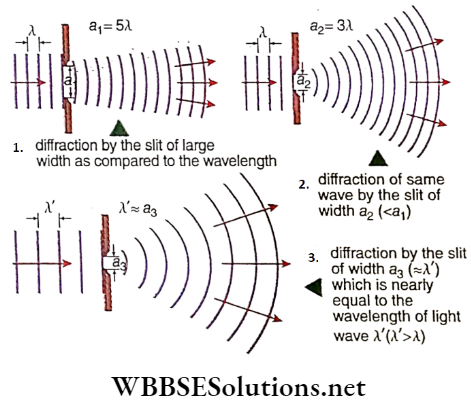
Now for the same wavelength oflight, as the aperture is gradually made finer, the diffraction of light becomes more distinct. On the other hand, a distinct diffraction can also be made to occur by increasing the wavelength oflight used, so that the slit can now be comparable in size with the wavelength of light .
Some Special Conclusions: Observing the phenomenon of diffraction of light
The following conclusions can be drawn:
- Like other waves, light also spreads like a wave
- If the size of the apertures is much larger than the wavelength of light, diffraction of light is not easily detectable. In
- In that case, can be said that light travels in a straight line. In the case of a very fine aperture, when light hends from its straight path, we come to know of the limitations of geometrical optics. That is why, the rectilinear behavior of light according to geometrical optics is actually an approximate behavior.
- When the edges of the obstacle or aperture are sharp, diffraction is more distinctly detectable.
- Diffraction validates the wave theory of light, but it does not give any information about the nature of light waves (whether it is longitudinal or transverse).
- As the wavelengths are long, sound waves and radio waves are diffracted more prominently than other kind of waves.
Optics
Diffraction And Polarisation Of Light Comparison Between Interference And Diffraction Of Light
Similarity: Both interference and diffraction of light take place due to the superposition of waves. Diffraction fringes are formed mainly due to the interference of waves.
Dissimilarity: There are some basic differences between interference and diffraction of light. The differences are as follows
Difference Between Interference And Diffraction
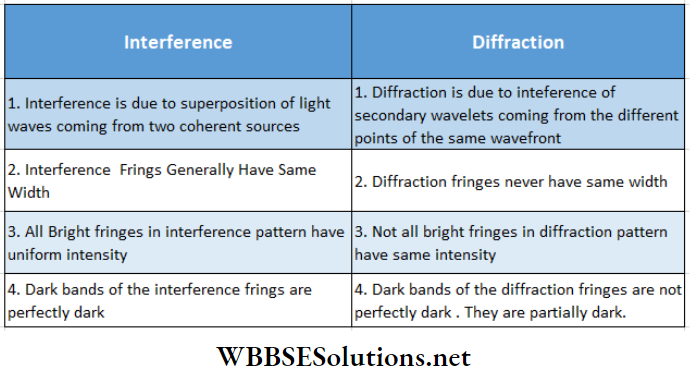
Optics
Diffraction And Polarisation Of Light Classification Of Diffraction
The phenomena of diffraction oflight can be classified mainly into two classes
- Fresnel diffraction and
- Fraunhofer diffraction.
1. Fresnel diffraction
- The diffraction, where both the source of light and the screen, are at finite distances from the obstacle or the aperture is called Fresnel diffraction.
- In this diffraction, wavefronts incident on screen are either spherical or cylindrical.
- Obstacles with sharp edges, narrow slits, thin wires, small circular obstacles or holes etc. can produce Fresnel diffraction.
2. Fraunhofer diffraction
- The diffraction, where the source of light and the screen are virtually at an infinite distance, is called Fraunhofer diffraction.
- In this case, the incident wavefront is a plane. Single slit, double slit, diffraction grating etc. produce Fraunhofer diffraction
Optics
Diffraction And Polarisation Of Light Fraunhofer Diffraction By Single Slit
Experimental arrangement
In this experiment of light from a monochromatic light source, Is made to a convex lens L1, through a narrow silt S. The slit S is held at e focus of the lens Lx. Hence, rays retracted from lens L1 parallel.
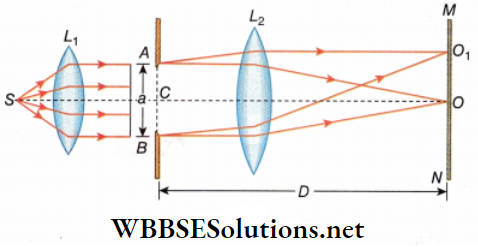
This parallel beam of monochromatic light is incident normally on the slit AB placed perpendicular to the plane of the paper. The ray is now focussed by a convex lens I1 on a screen MN, where we observe diffraction fringes. Instead of the screen, if the diffraction pattern is observed by an objective, the tire pattern will be observed in its focal plane
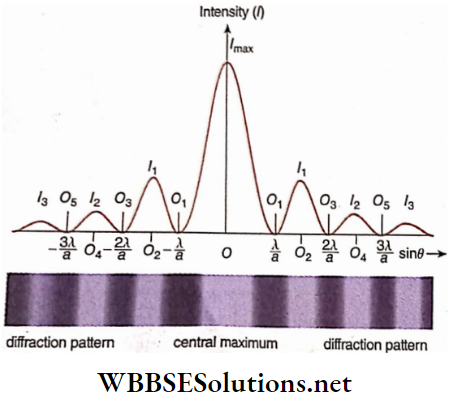
Fraunhofer Diffraction By Single Slit Explanation
According to geometrical optics, light rays merging out from the slit AB, if focussed by the lens L2, should produce a sharp image of the slit, at point O of the screen. But actually, this does not happen.
This is because light is passing through AB, and does not propagate in straight lines. Getting diffracted by AB, the light rays spread upwards of point A id downwards of point B. So with the formation of a sharp Image of the slit O, alternate bright ml dark diffraction fringes are produced on both sides of O
Central of principle maximum
Is the midpoint of the silt AB. CO Is the principal axis, the livery point of the plane wavefront, which Is an Incident on the slit, and Is of tho name phase. All wavelets originating from those points and proceeding parallel to CO are focussed by L2 at O. Since those wavelets have no path difference, they are In the same phase. So, they make constructive Interference, and point O appears very bright. O is called principal or control maximum. Simplified form of
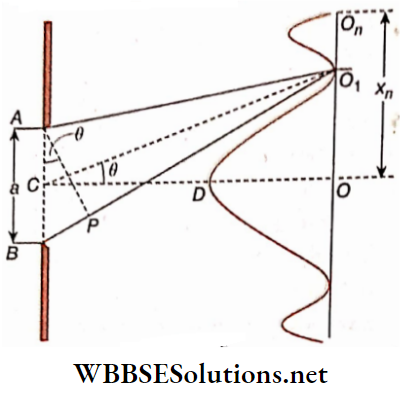
Conditions for the formation of minima and secondary maxima
Suppose, some wavelets after being diffracted through an angle are focussed at Ox by the lens L2
Now, the condition for the formation of constructive or destructive interference at the point Ox depends on the path difference of the wavelets originating from A and B. From A, a perpendicular AP is drawn on BOx.
So the path difference between the wavelets emergent from points A and B =BP. Now, BP =AB sin ∠BAP = a sin θ
[where, AB = a- width of the slit]
1. For minima:
To obtain the condition for minima being formed at O1, slit AB is notionally divided into halves, AC and CB, i.e., AC = CB = \(\frac{a}{2}\)
Let the wavelength of incident monochromatic light = λ. If the path difference between two wavelets, originating from points A and C be \(\frac{\lambda}{2}\) they would cause destructive interference.
S°, the condition of formation of first minima on both sides of O for diffracting angle θ1 is,
⇒ \(\frac{a}{2} \sin \theta_1=\frac{\lambda}{2} \quad \text { or, } a \sin \theta_1=\lambda\)
Or, \(\sin \theta_1=\frac{\lambda}{a}\) …………………………… (1)
In general, the condition for the formation of n th minimum on both sides of O, for diffracting angle θn is, a side = nλ …………………………… (2)
Putting n = ±1, ±2, ±3,…………. in equation (2), we would get simultaneously, first, second, third etc. minima on either side of the principal maximum. Here, ± sign is used to indicate diffractions on either side of the central line.
2. For secondary maxima:
If the path difference of the wavelets emitted from A and B, BP = \(\frac{3 \lambda}{2}, \frac{5 \lambda}{2}, \cdots(2 n+1) \frac{\lambda}{2}\) then at points O2, O4, etc. they would produce first, second, etc. maxima. At these points, the two waves superpose in the same phase. These are called secondary maxima. If ‘ is the corresponding angle of diffraction for the nth secondary maximum, then
⇒ \(a \sin \theta_n^{\prime}=(2 n+1) \frac{\lambda}{2}\) ………………..(3)
[where, n = ±1, ±2, ±3……. etc.]
It is to be noted that the intensity of the secondary maxima gradually decreases
The linear distance of the nth minimum from the central maximum
Generally, the wavelength of visible light (for example, A = 5 × 10-7m) is much lower than the width of the slit (for example, a = 10-4m ). For such values of θ, sin θ ≈θ. With this approximation, equation (2) becomes
⇒ \(\theta_n=\frac{n \lambda}{a}\) …………………………(4)
Let the distance from principal maximum point 0 to n th minimum point On, OOn = xn and distance from screen to slit =D
As the value of θn is very small, \(\theta_n=\frac{x_n}{D}\)
Putting the value of θn in equation (4) we get
⇒ \(a \cdot \frac{x_n}{D}=n \lambda \quad \text { or, } x_n=\frac{n \lambda D}{a}\) ………. (5)
Putting n = ±1,±2, ±3-” etc. in equation (5), linear distances of various minima from central maximum are obtained
Width of central maximum
The angle between the first minima on either side of the central maximum is called the angular width of the central maximum.
According to equation (4), the angular spread of the central maximum on either side is
⇒ \(\theta=\frac{\lambda}{a}\)
Angular width of central maximum,
⇒ \(2 \theta=\frac{2 \lambda}{a}\) ……………………. (6)
Therefore, linear width of central maximum \(=D \cdot 2 \theta=\frac{2 D \lambda}{a}\) where D = distance of slit from the screen. If lens L2 is located very close to the slit AB, or if the screen MN is located far away from lens L2 > then D ≈the focal length of the lens (f).
In that case, linear width central maximum point In general, the condition for the formation of n th minimum on = \(\frac{2 f \lambda}{a}\)
Optics
Diffraction And Polarisation Of Light Resolving Power Of Optical Instruments
Two types of resolving power are relevant for different optical instruments: O Spatial resolving power and Q Spectral resolving power.
Spatial or angular resolving power
Our eye is an optical instrument. If two point objects (or their images) are very close to each other, our eyes may not see them as separate objects. They seem to be the same object or the same image. It can be verified by a simple experiment.
Let a white paper be fixed on a wall in front of us. On the paper black parallel lines are drawn at 2 mm distance apart. When we stand very close to the wall, we can see all the parallel lines. When we gradually move away from the wall, the angle formed by any two lines at our eye gets diminished and at one point it seems that die lines have merged with each other i.e., the lines can no longer be identified separately.
It can be inferred that whether two objects placed side by side can be differentiated, depends on the angle formed by the two objects at our eyes. It has been established through experiments that if the angle becomes less than 1 minute or \(\frac{1}{60}\) degree, eyes will not be able to see two objects separately.
This angle is called the angular limit of the resolution of our eyes. This means our eyes, as well as optical instrument, has their own limit of
Resolving images of two different objects located very near to each other:
- Limit of Resolution: The limit of Resolution is the smallest linear distance or the angular separation between two objects that can be directly seen through an optical instrument, is called the spatial limit of resolution of that instrument.
- Resolving power: The power or ability of an instrument to produce distinct separate images of two close objects, is called the spatial resolving power of the instrument.
Spatial resolving power is measured by the reciprocal of the limit of resolution. If Δx or is the linear or angular limit, then the resolving power would be \(\frac{1}{\Delta x} \text { or } \frac{1}{\Delta \theta}\) respectively
Spectral resolving power
Instruments like prism and diffraction grating are used to separate spectral lines of different wavelengths. For example, the D, and D2 lines of sodium spe trim have a separation of 6 A of wavelength between them. Usually, a prism cannot separate them, but a diffraction grating can. So we say that the limit of resolution of a grating is 6 A° or less, whereas that of a prism is greater than 6 A°.
If an optical instrument just resolves two spectral lines of wavelengths λ and λ + Δλ, then its limit of resolution is defined as Δλ and its spectral resolving power as \(\frac{\lambda}{\Delta \lambda}\)
Rayleigh criterion:
This defines the spectral limit of resolution of an optical instrument. Its statement is:
Two images are said to be just resolved when the central maxi¬ mum in the diffraction pattern due to one of them is situated at the first minimum in the diffraction pattern due to the other.
It is to be noted that, spatial resolving power is intimately related to spectral resolving power; because, to observe the spatial 1. on stars separation between two objects, we often have to use Instruments working on the principle of wavelength separation, phenomenon of diffraction, etc.
Resolving power of Microscope
If a microscope is able lo show the image, of two point objects, lying close lo each other, separably, then the reciprocal of the distance between these two objects is the resolving power of that microscope.
This power depends on the wavelength (λ) of light used, the refractive index (μ) of the medium between two objects and the objective of the microscope, and the cone angle (θ) formed by the radius of the objective on any one of the objects
If the internal distance between two objects is And, then the resolving power of the microscope’
R = \(\frac{1}{\Delta d}=\frac{2 \mu \sin \theta}{\lambda}\)
To increase the resolving power of a microscope, the objects and the objective of the instrument are immersed in oil. Hence, as the value of fj increases, the resolving power, R also increases.
The expression μ sinθ is called the numerical aperture of a microscope. It is a special characteristic of a microscope. It is mentioned in some microscopes
Resolving power of Astronomical Telescope
When a telescope is able to analyze two separate distant objects lying closely, then the reciprocal of the angle subtended by the two objects at its objective is called the resolving power of that telescope.
If the angle subtended, by the two objects at the objective, be Δθ, then the resolving power of the telescope,
R = \(\frac{1}{\Delta \theta}=\frac{a}{1.22 \lambda}\)
[where a = diameter of the objective of the telescope]
Hence, if the diameter of the objective of the telescope is increased, its resolving power increases. Again if the wavelength of the incident light decreases, The resolving power increases.
- The angular spread Ad of a telescope depends solely on its objective. If the objective of a telescope is unable to analyze two stars located extremely far away, then these cannot be analyzed by the telescope even by increasing the magnification of its eye piece.
- To see different astronomical objects in the sky, telescopes widi an objective having a diameter 1mm or more are used
Optics
Diffraction And Polarisation Of Light Polarisation Of Light
Polarisation of light Definition:
The phenomenon of restricting the vibrations of the electric vector of a light wave along a particular axis in a plane perpendicular to the direction of the light wave is called polarisation of light.
The phenomena of interference and diffraction demonstrate that light propagates in the form of waves. Butitis is not understandable from interference and diffraction, whether the light waves are transverseorlongitudinalinnaturebecausebothlongitudinaland transverse waves exhibit interference and diffraction.
The topic of discussion of this section is the polarisation of light. This phenomenon of light distinctly proves that light waves are transverse in nature and not longitudinal like sound waves.
Polarisation of mechanical waves
Two narrow slits A and B are cut in the middle portions of two cardboards C1 and C2. A thin long string OE, tied at one end E to a rigid support is passed through the slits A and B
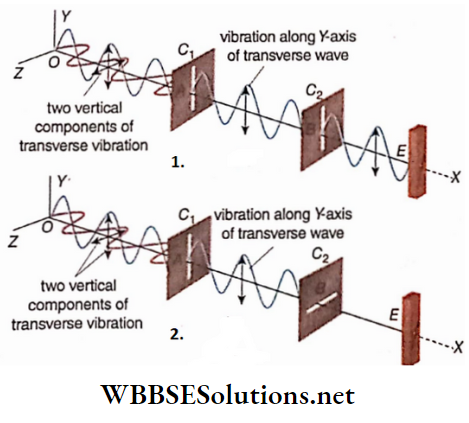
Now holding the end O of the string, it is made to vibrate perpendicularly along the direction to result,is a taken transverse long wave OE, the advanced particles of the string will vibrate perpendicular to the x-axis, i.e., In the y: plane. Holding the end O, the string can be made to vibrate randomly i.e., In any direction in the yz plane. In that case, each particle of the string, in the intermediate portion of the string between O and A, will have two vertical components of transverse vibration along the y and z-axes
At first tire cardboards, C1 and C1 are so placed that both the slits A and B are parallel to y-axis. Clearly, the component of vibration will be obstructed by the slit A, but the y -component will pass through A without any obstruction and reach the section AB.
So in spite of random vibrations of the string in portion OA, the vibration of the string in section AB will be confined only along the y-axis. This phenomenon of converting the random vibrations of a transverse wave to unidirectional vibration is called polarization.
In this case, the transverse wave in section OA is unpolarised, but it turns into a polarised wave in die section AB by the slit A because the wave of this section (section AB ) vibrates only along the y-axis.
Since slit B is parallel to the y-axis, so the vibration of the wave along y-axis in the section AB, will pass through slit B also without any obstruction. Thus, the transverse wave will propagate up to point E.
Now if the slit B is rotated through 90° with respect to OE, then the slit becomes parallel to the z-axis. Clearly, the vibrations of the string of section AB along the y-axis, get completely obstructed by the slit B. So, no vibration exists in the section BE of the string i.e., the transverse wave cannot propagate along BE.
From the above discussion, it is clear that if the vibration is longitudinal, that is, parallel to the x-axis, then, they are not at all obstructed by slits A and B in any of their orientations. Thus the longitudinal wave can propagate up to point E. Hence, it can be said that polarisation is a phenomenon that is not exhibited by longitudinal waves. For example, sound wave is a longitudinal wave, hence sound wave is not polarised.
Unpolarised Light
In the usual sources of light like the sun, candle, electric lamp, etc., electrons, ions, or other charged particles vibrate randomly. Hence the transverse vibrations of the waves emitted from these sources have no definite direction.
This type of light is called ordinary light or unpolarised light. In this case, the transverse vibration may be referred to as the sum of the two perpendicular components of equal amplitude.
Light is an electromagnetic wave. The electric field £ and the magnetic field B of this wave always vibrate perpendicular to the direction of the wave. The vibration is confined to a certain plane. The wave propagates in a direction perpendicular to the plane
The polarization of light can be easily explained by an experiment with tourmaline crystals.
Experiment with a tourmaline crystal
Tourmaline is a hexagonal crystal. The crystal cut in the form of a thin plate behaves almost like a transparent substance. The longest diagonal of the hexagonal crystal is called the crystallographic axis or optical axis C1 and C2 are two thin tourma¬ line crystal sheets and M1N1 and M2N2 are their optical axes respectively
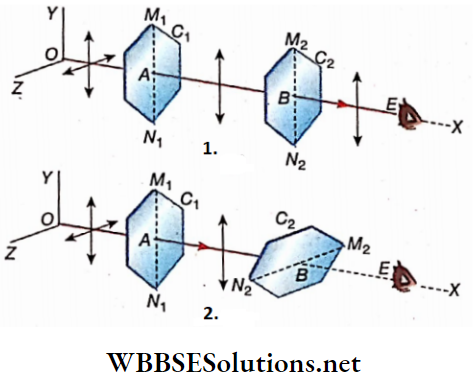
O is an ordinary source of light. Keeping the eye fixed at position E, one is looking towards O. Here x-axis is taken along OE. At first, the crystal C1 is placed on the way of the ray OE at location A in such a way that its optical axis M1N1 lies perpendicular to x -x-axis.
If the crystal is so placed, the intensity of light is found to be a little diminished. If the crystal is made to rotate about OE as the axis of rotation, the intensity of the transmitted light remains unchanged.
Now the crystal C2 is also placed at B on the way of the ray OE in such a way that the optic axes of both C1 and C2 are parallel to y -axis. It is found that light comes out undiminished in intensity in spite of C2 being placed.
But as the crystal C2 is rotated slowly about point B with OE as the axis of rotation, it is found that the intensity of light decreases. When the axis of C2 makes an angle 90° with the axis of C1i.e., crystallographic axis M2N2 becomes parallel to the z-axis, no light from the source reaches the eye. When C2 is rotated further, the intensity of the light gradually increases. When C2 is rotated through another 90°, i.e.,it is rotated through 180° from its initial position, light reappears with its earlier intensity
Explanation of the result of the experiment
The above experiment can be explained if we consider light waves as transverse nature and the crystallographic axes of the tourma¬ line crystals as narrow slits. The transverse vibrations of the light waves emitted from the source O are random in nature.
So, two perpendicular components of vibration along y and z-axes exist in each point of the section OA of the light ray. Since the axis M1N1 of the crystal C1 is placed parallel to y -y-axis, so the y -y-component of the transverse vibration of the light wave passes through the crystal, but the z -z-component is completely absorbed. Since one component is absorbed completely, the intensity of the transmitted light becomes half. Only y -the component of the transverse vibration of the light wave has been shown in section AB
Now if the crystallographic axis M2N2 of the crystal C2 also becomes parallel to y -the axis, the y -y-component of the transverse vibration passes through the crystal and reaches the eyes But by rotating the optical axis M2N2 through 90°, if it is placed parallel to z-axis, the crystal C2 absorbs the y component of the vibration completely.
So, no vibration exists in the section BE, lightwave is absent here. Hence no light reaches the eye When crystal C2 is rotated through another 90° i.e., when total rotation is 180°, the optical axis M2N2 becomes parallel to the y-axis again, as a result, the y -component of the transverse vibration can pass through the crystal C2
Polarised Light Conclusion:
When an ordinary light wave passes through a tourmaline crystal or a similar medium, its random transverse vibrations are converted to a unidirectional transverse vibration.
This phenomenon is called polarisation of light and the light is called polarised light. In the, light of the section AB is called polarised light.
Any transverse wave, like a light wave can be polarised.
Polariser:
The instrument by which unpolarised light is made polarised is called a polariser. The tourmaline crystal C1 is called the polariser and the crystallographic axis M1N1 is called polarising axis.
Analyzer:
The instrument examines whether light is polarised or not and the type of polarization. Is called analyser. The tourmaline crystal C2 is called an analyzer because it examines whether the light is polarised or not and what type of polarization has been produced by the crystal C1.
When the crystallographic axes of the crystals C1, and C2 arc parallel, It is called the parallel position of polarizer and analyzer. When their crystallographic axes are perpendicular to each other, they are said to be in a crossed position.
Optics
Diffraction And Polarisation Of Light Plan Of Vibration And Plane Of Polarisation
Plane of vibration Definition: The plane in which the vibration of the polarised light remains confined is called the plane of vibration.
Plane of polarisation Definition: The plane containing the ray of light and perpendicular to the plane of vibration is called the plane of polarisation.
Description:
The direction of propagation of the polarised light through the tourmaline crystal AB is shown. Light rays are advancing along x -the axis and the electric field of polarised light is vibrating along y -the y-axis, xy plane i.e., the plane ABCD is the plane of vibration of polarised light.
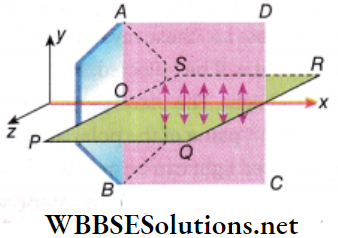
Unit 6 Optics Chapter 7 Diffraction And Polarisation Of Light Plane Polarised Or Line arly Polarised Light
Plane-polarised or linearly polarised light Definition: If the vibration of polarised light remains confined In a plane and takes place along a straight line, then it is called plane-polarised or linearly polarised light.
The vibration of an electric field of a light wave on a plane perpendicular to the direction of propagation of an ordinary light or unpolarised light can take place In any direction from a point. The direction of vibration In a particular plane perpendicular to the direction of propagation of a ray of light, Is shown by the arrowheads In different directions in that plane
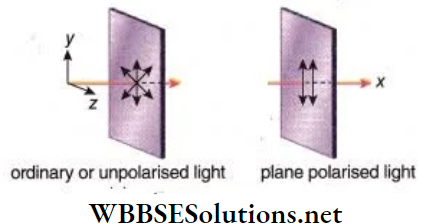
Convention of representation of unpolarized and polarised light:
In the plane of the paper, unpolarUed and polarised lights are represented according to the following conventions.
Ordinary light i.e., unpolarised light has vibration In all directions In a plane, perpendicular to the direction of propagation of light It is supposed to be made up of two mutually perpendicular vibrations. Hence ordinary unpolarized light is shown with dots and lines with arrows in opposite directions at the same time
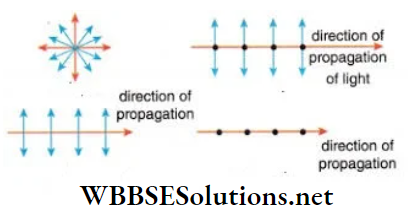
If the polarised light has vibrations in the plane of the paper, it is shown with lines haring arrows in opposite directions perpendicular to its direction of propagation
If the vibration of polarised light in a direction perpendicular to the plane of the paper
They are shown by dots on the line of propagation:
- When unpolarised light is transmitted through an analyzer, its intensity is halved.
- 2. If polarised light is incident on an analyser dien die intensity of the transmitted light is given by Malus’ law.
Malus’ law:
When a beam of completely plane polarised light is incident on an analyzer, the resultant intensity of light (I) transmitted from the analyzer varies directly as the square of the cosine of the angle (θ) between the plane of transmission of the analyzer and polariser i.e
⇒ \(I \propto \cos ^2 \theta \text { or, } I=I_0 \cos ^2 \theta\)
Where I0 is the intensity of the light incident on the analyzer.
Diffraction And Polarisation Of Light Polarisation By Reflection
In 1808 French scientist E L Malus discovered that plane polar¬ ised light can be produced by reflection. He showed that when ordinary light i.e., unpolarised light is reflected from the surface of a transparent medium such as glass or water, the reflected light becomes partially plane polarised. The degree of polarisation depends upon the angle of incidence
Angle of polarisation Definition:
For a particular angle of incidence, the degree of polarisation by reflection is maximized. This angle of incidence is called the angle of polarisation or polarising angle
The magnitude of this angle depends on the nature of the reflecting surface and the wavelength of the Incident light
For glass, the polarising angle Is an hour, and for pine water, it Is about 53°
The experiment of polarisation by reflection
Let us sup. pose, a black glass plate is placed perpendicularly a sheet of paper. MM’ is the smooth upper surface of the plate This is the reflecting surface. As the glass is black, the possibility of more than one reflection of the refracted ray is less. An ordinary’ my of light AO is incident on the reflecting surface at an angle 5(5° and is reflected along OH. The reflected ray OB will be plane-polarised.
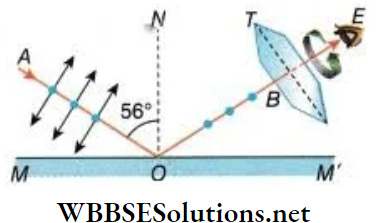
To examine, a tourmaline crystal ( T”) is placed OB and looked from point E located behind the crystal along BO. Now the crystal is rotated slowly about the reflected ray OB. It will be seen that at a particular position of the crystal, no light Is transmitted through the crystal. The crystal is again rotated from this position slowly and when the rotating angle becomes 90°, the Intensity of light transmitted by the crystal will be maximum. This proves that the reflected beam OB is polarised.
Polarisation by Reflection Explanation:
The transverse vibrations of ordinary incident light may be supposed to consist of two mutually perpendicular vibrations
- One component in the plane of the paper i.e., lies in the plane of incidence and
- The other perpendicular to the plane of paper i.e., lies parallel to the reflecting surface.
Whatever be the value of the angle of incidence on MM’s plane, the vibration of the second component will always be parallel to the reflecting surface. As a result, if the incident angle changes, the vibration of that component will be parallel with the reflecting plane MM’ but the vibrations of the first component will make varying angles with the reflecting plane. If light is incident at a polarising angle, the vibrations will be refracted from air to glass and get absorbed inside the glass i.e., these rays will not be reflected.
Only the second component will be reflected. Hence reflected ray OB is the plane polarised light. The plane perpendicular to the sheet of paper is the vibration plane of die-polarised light. So, it can be said that plane-polarised light can be produced by reflection
Optics
Diffraction And Polarisation Of Light Brewster S Law
When polarised light is incident at a polarising angle on the interface of two media of different refractive indices; a portion of that light is reflected and completely polarised and the other portion is refracted and partly polarised.
It has been found from the experiment that in the event of such an unreflective and refraction of an unpolarised light, incident polarising angle, the reflected ray and the refracted ray become mutually M perpendicular.It is to be mentioned here that this polarising angle is also called Brewster’s angle
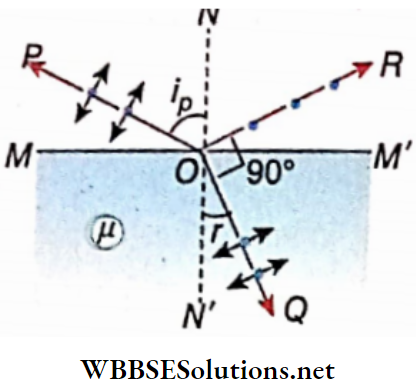
In ∠PON = angle of polarisation (polarising angle)
= ip and ∠QON’ is the corresponding angle of refraction = r.
Then , ip + r= 90°
Or, r = 90° – ip ………………………… (1)
Then, according to Snell’s law; \(\frac{\sin i_p}{\sin r}=\frac{\mu_2}{\mu_1}\)
[where μ 1 = refractive index of the medium of incidence
μ 2= refractive index of the medium refracting of incidence
⇒ \(\frac{\sin i_p}{\cos i_p}=\frac{\mu_2}{\mu_1}\)
Or, \(\tan i_p=\frac{\mu_2}{\mu_1}\) ………………………… (2)
If both the incident ray and the reflected then px = 1
In that case, if refractive index of the refracting medium is taken as n, the equation (2) can be written as follows
tan ip = μ
i.e., the tangent of a polarising angle is numerically equal to the refractive, the index refractive of the index refractive of the index reflecting of a medium. depends this is Brewster’son the wavelength depends of on light wavelength.It can be said that the polarising angle also
Optics
Diffraction And Polarisation Of Light Polarisation By Refraction Brewster S Law
When an ordinary (unpolarised) light is incident on the upper surface of a parallel-faced glass plate at the polarising angle, the reflected light is completely plane polarised but its intensity is very low.
A major portion (about 85%) of the incident ray is refracted and only a very small portion (15%) is reflected. The refracted ray is also partly polarised. The two planes of polarisation of completely polarised reflected ray and partly polarised refracted ray are at right angles to each other.
So it is not possible to get a strongly reflected beam of polarised light with the help of a single plate. To overcome this defect, a number of plane parallel glass plates are placed parallel to each other and an unpolarised light is allowed to fall on the first plate at the polarising angle.
Due to successive reflections, strong beams of polarised reflected light will be obtained. Ultimately two plane polarised light will be separated one reflected polarised light with vibrations perpendicular to the plane of the paper i.e., the plane of incidence, and another refracted polarised light with vibrations in the plane of the paper
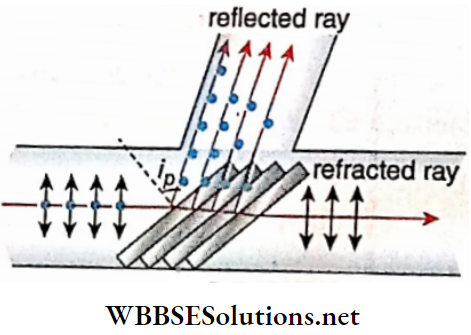
Optics
Diffraction And Polarisation Of Light Double Refraction Or Birefringence
In 1669 Ramus Bartholin discovered that when an ordinary ray of light is incident perpendicularly on the surface of a calcite crystal, it splits into two rays due to refraction
one of the refracted rays obeys the laws of refraction and is called the ordinary ray or O -ray. The other refracted ray does not obey these laws hence it is called the extraordinary ray or E- ray Both of these rays are plane polarised in mutually perpendicular planes.
The phenomenon by virtue of which an unpolarised ordinary ray, on entering a crystalline substance,
Splits up into two rays:
- Herapathite la an organic compound whose chemical name is iodoquine sulphate.It is a dichroic crystal used to polarise light rays.
- Each polaroid hasaparticularplaneofpolarisation.Apolaroid allows only those incident unpolarised light rays to refract, whose vibration plane is parallel to the polarisation plane of the polaroid. The direction of this polarisation plane of the polaroid is called the transmission axis
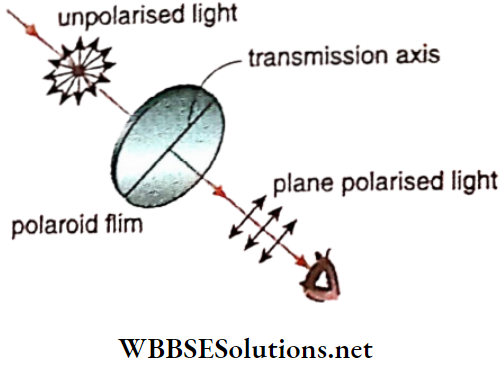
- Uses of PolaroidWith the help of polaroids, plane polarised light can be produced and analyzed very easily at a low cost
- Polaroids are widely used as polarising sunglasses.
- Polaroids are used to eliminate the headlight glare in motor cars.
- Polaroids are used as glass windows in trains and airplanes to control the intensity of light coming from outside.
- In calculators and watches, letters and numbers are formed by liquid crystal display (LCD) through the polarisation of light.
- Polaroid films are used in making 3D cinema or picture
Diffraction And Polarisation Of Light Numerical Examples
Example 1. For producing a Fraunhofer diffraction fringe, a screen, Is placed 2m away from a single narrow slit. If the width of the slit is 0.2 mm, It is found that the first minimum lies 5 mm on either side of the central maximum. Find the wavelength of the incident light
Solution:
We know, if the distance between n nth minimum and the Central maximum is, the
⇒ \(x_n=\frac{n D \lambda}{a}\)
Or, 0.5 = \(\frac{1 \times 200 \times \lambda}{0.02}\)
[Here , n= 1 xn = 5mm = 0.5 cm , D = 2m = 200 cm , a= 0.2 mm = 0.02 cm ]
⇒\(\frac{0.5 \times 0.02}{1 \times 200}\)
= 5000 × 10-8 cm
= 5000 A°
Example 2. A single narrow slit of width 0.1 mm, with a parallel beam of light of wavelength 600 × 10-9 m. An interference fringe is formed on a screen 40 cm away from the slit. At what distance, will the third minimum band be formed from the central maximum band?
Solution:
We know, if the distance of the nth minimum from the central maximum is xn, then
⇒ \(x_n=\frac{n D \lambda}{a}\)
[Here, n = 3, a = 0.1 mm = 0.01 cm D = 40 cm and A = 600 × 10-9 m= 600 × 10-7 cm ]
⇒ \(\frac{3 \times 40 \times 600 \times 10^{-7}}{0.01}\)
= 0.72 cm
Example 3. A Fraunhofer diffraction pattern is formed by light, of wavelength 600 nm, through a slit of width 1.2 μm. Find the angular position of the first minimum and the angular width of the central maximum.
Solution:
If the angular position of the first minimum with respect to the central maximum be θ, then
sin θ = \(\frac{\lambda}{a}=\frac{600 \times 10^{-9}}{1.2 \times 10^{-6}}\)
= 0.5 = \(\frac{1}{2}\)
= sin 30°
θ = 30° [ Here , = 600 nm = 600 × 10-9 m
a = 1.2 μm = 1.2 × 10-6 m
∴ Angular width of central maximum = 2θ = 2 × 30° = 60°
Example 4. A Fraunhofer diffraction pattern is formed by a light wave of frequency 5 × 10-4 Hz through a slit of width m. Find the angular width of the central maximum [ Velocity of light in vaccum] = 5 × 10-8m.s-1
The angular width on either side of the central maximum
⇒ \(\frac{\lambda}{a}=\frac{c}{\nu a}\)
= \(\frac{c}{\nu}\)
= \(\frac{3 \times 10^8}{5 \times 10^{14} \times 10^{-2}}\)
[Here, ν = 5 × 1014 Hz
a = 10-2M , C = 3 × 10-8m.s-1
= 0.6 × 10-4 rad
∴ Angular width of central maximum = 2 = 1.2 × 10-4 rad
Example – 5. A single narrow slit of width It Illuminated by a monochromatic parallel ray of light of wavelength 700 nm. Find the value of an In each cate following the given conditions
First minimum for 30 diffraction angle and
First secondary maximum for 30° diffraction angle
From the conditions of formation of n nth minimum,
a sin = n λ
a sin 30° = 1 × 700 × 10-9 m
Since θ = 30°, n= 1
And λ = 700 nm = 700 × 10-9 m]
a = \(\frac{700 \times 10^{-9}}{\frac{1}{2}}=14 \times 10^{-7}\)
From the condition of formation of n nth secondary maximum
a sin = (2n +1) \(\frac{\lambda}{2}\)
Or, a sin = \(\frac{3}{2} \times 700 \times 10^{-9}\)
= 30° for 1st secondary maximum, n = 1 and λ = 700 nm e 700 × 10-9 m
∴ a = 21 × 10-7 m
Example 6. A Star Is observed through a telescope. The diameter of the objective of the telescope is 203.2 cm. The wave¬ length of the light, corning from the star to the tele¬ scope U 6600A. Find the resolving power of the telescope.
Solution:
Resolving power of a telescope
R = \(\frac{a}{1.22 \lambda}=\frac{203.2}{1.22 \times 6600 \times 10^{-8}}\)
= \(2.52 \times 10^6\)
= 2.52 × 10-6
Here, the diameter of the objective of the telescope,
a = 203.2 cm
And wavelength of the Incident light, λ = 6600 A° = 6600× 10-8cm
Example 7. Find the Brewster angle for *|r to glass transmission.(R.1. of glass = 1.5)
Solution:
If the refractive index of glass relative to air be p and the polarising angle he ip, then according to Brewster’s law we have,
μ = tan ip Or, tan ip = 1.5
ip = tan-1 (1.5) = 56. 3
Example 8. A single narrow till of width a U Illuminated by white light or whal value of a will the for minimum of rd light of wavelength 650 nm, lie al point PI For what wavelength of the Incident light will the first secondary maximum lie at point P?
Solution:
From the condition of formation of the first minimum at point P.
a sin θ = nλ
Here, n = 1 , θ= 30° and A 650 nm
a sin 30° = 1 × 650 or, a = 1300 nm
a sin θ = \((2 n+1) \frac{\lambda^{\prime}}{2}\)
Or, a sin θ = \(\frac{3}{2} \lambda^{\prime}\)
[Here, A’ – wavelength to be determined and n Or, \(\lambda^{\prime}=\frac{2}{3} a \sin \theta\)
= \(\frac{2}{3} \times 1300 \times \frac{1}{2}\)
= 433.33
The required wavelength a 433.33 nm
Example 9. The refractive Index of glass la 1.55. What is the polarising angle? Determine the angle of refraction for the polarising angle.
Solution:
If the refractive index of glass relative to air be μ and the polarising angle be ip, then according to Brewster’s law we have.
μ = tan ip or, tan ip = 1.55
ip = tan-1(1.55) = 57. 17°
Again for Incidence at the polarising angle,
ip + r = 90° [here r = angle of refraction]
Or, r = 90°- ip = 90°- 57.17º = 32.83
Example 10. The critical angle of n transparent crystal is 30°, What is the polarising angle of the crystal?
Solution:
If μ is the refractive Index and θc. is the critical angle of the crystal, then
μ = \(\frac{1}{\sin \theta_c}=\frac{1}{\sin 30^{\circ}}\) = 2
From Brewster’s law, we have
tan ip =μ
[Here ip = polarising angle]
Or, tan ip = 2 Or, ip= tan-1 (2) = 63. 43°
Example 11. Determine the polarising angle of the light ray moving from the water of a refractive index of 1.33 to a glass with a refractive index of 1.5
Solution:
From Brewster’s law, we have,
⇒ \(_w \mu_g=\tan i_p\)
[Here ip = Polarising angle]
Or, \(\frac{a^{\mu_g}}{{ }_a \mu_w}=\tan i_p\)
Or, \(\frac{1.5}{1.33}=\tan i_p\)
Or, tan ip = 1.13
Or, ip = tan-1 (1.13) = 48. 5
Example 12. When sun rays is incident at an angle 37 on the water surface, the reflected ray gets completely plane polarised. Find the angle ofrefraction and refracttve Index of water
Solution:
According to the question, angle of incidence
= (90° -37°) = 53°
The angle of polarization, ip = 53°
Now, ip + r = 90°
Or, r = 90° – ip
Or, r = 90°- 53°= 37°
According to Brewster’s law, the refractive index of water
μ = tan ip = tan 53 °= 1.327
Diffraction And Polarisation Of Light Synopsis
1. When a wave passes close to the edges of an obstacle or an aperture, the direction of motion of the wave gets changed. This is called the diffraction of the wave.
2. Light is a wave, so it has the property of diffraction. Light, while passing around the edges of an obstacle or an aperture, bends a little departing from straight-line propagation. This incident is called the diffraction of light.
3. As wavelength increases, the amount of bending i.e., dif¬ fraction also increases. Hence sound waves and radio waves are diffracted more as their wavelengths are large.
4. Fringes of diffraction are formed due to interference of the waves.
5. There are two types of diffraction phenomena. They are— O Fresnel’s diffraction and Fraunhofer’s diffraction.
6. In Fresnel’s diffraction, the source of light and the screen on which the diffraction pattern is observed are at finite distances from the obstacle or aperture.
7. On the other hand/ In Fraunhofer’s diffraction, the source of light and the screen are virtually at an Infinite distance from the obstacle or aperture. Single narrow silt produces Fraunhofer’s diffraction.
8. Single narrow slits produce diffraction fringes on the screen. On either side of the central maximum, minima and secondary maxima are formed. The intensity of the secondary maxima gradually decreases.
9. If a microscope is just able to sec two objects, lying close to each other, separately, then the reciprocal of the distance between the two objects Is the resolving power of that microscope.
10. When a telescope Is able to analyse distinctly two separate objects lying closely, then the reciprocal of the angle subtended by the two objects at the objective of the telescope, Is called its resolving power.
11. Light emitted from the usual sources like the sun, candle, electric lamp etc. are unpolarised light.
12. Hit phenomenon of restricting the vibrations of an electric vector of a light wave along a particular direction of axis, In a plane perpendicular to the direction of the light wave. Is called the polarisation of light
13. When an unpolarized light wave passes through a tourma¬ line crystal or similar medium, its random transverse vibrations are converted into a unidirectional transverse vibration.
14. Polarisation proves that a light wave is transverse Sound waves can not he polarised as is a longitudinal wave.
The plane in which the wave. vibration of the polarised light remains confined is called a plane of vibration. The plane drawn through the light rays which are perpendicular to the plane ol vibration Is called the plane of polarization
15. Plane-polarised light can be produced by reflection. For a particular angle of incidence, the degree of polarisation by the reflection is maximum. This angleofincidenceiscalledangle polarization or Brewster’s angle. The magnitude of this angle depends on the nature of the reflecting surface.
16. When a ray of light is incident at the interface of two media at a polarising angle, the reflected and the refracted rays become perpendicular to each other.
17. Brewster’s law: The tangent of the polarising angle is numerically equal to the refractive index of the refracting medium.
18. When an ordinary ray of light (unpolarised ray) is incident perpendicularly on the surface of a calcite crystal, it splits into two rays due to refraction. One of the refracted rays is called an ordinary ray or O -ray which obeys the common
19. Laws of refraction and the other is called extraordinary ray or E -ray which does not obey these laws. This Incident Is called double refraction or birefringence. The crystals In which double refraction takes place are called double-refracting crystals. Examples of such crystals are calcite, quartz, tourmaline, etc.
20. Double refracting crystals are classified Into two types
- Negative crystal and positive crystal.
- In negative crystals (tourmaline, calcite),
μo > μE ,> VE>Vo
And in positive crystals (ice, quartz),
μo > μE ,> Vo>VE
21. A polaroid is a polarising sheet or film by which polarised light can be produced.
In the single-slit experiment, the condition for the formation of the nth minimum
a sin n = n λ
Where n = ±1,±2,±3, , a = width of the slit
λ = wavelength of light used and 8n = diffraction angle]
22. Distance of nth minimum from the central maximum,
⇒ \(x_n=\frac{n \lambda D}{a}\)
Where D= distance of the screen from the slit
Condition for the formation of the nth secondary maximum
⇒ \(a \sin \theta_n^{\prime}=(2 n+1) \frac{\lambda}{2}\)
Where n = +1, ±2, etc
23. Angular width of central maximum = \(\frac{2 \lambda}{a}\)
24. Linear width of central maximum = \(\frac{2 \dot{D} \lambda}{a}\)
Malus’ law: I = Io = cos²θ
Where Io = Intensity of the light incident on the analyzer.
25. Brewster’s law: pt = tan ip
Where n – refractive index of the refracting medium with respect to air, ip = angle of polarization.
26. ip + r = 90°; where r = angle of refraction
Diffraction And Polarisation Of Light Very Short Questions And Answers
Question 1. Do the sound waves have the property of diffraction?
Answer: Yes
Question 2. What idea does diffraction of light give about the nature of light light waves?
Answer: Gives no idea
Question 3. Why do we feel more diffraction in sound waves than in light waves?
Answer: As the wavelength of sound is larger than the light wave
Question 4. While passing around the comer of an obstacle, the bending with the increase of the wavelength of light
Answer: Increases
Question 5. What should be the nature of the incident wavefront ir case of Fresnel’s diffraction? Answer: Spherical or cylindrical diffraction
Question 6. A single slit produces ‘ diffraction [Fill in the blank].
Answer: Fraunhofer
Question 7. In Fresnel’s diffraction, the source of light is located at a distance from the aperture (silt)
Answer: Finite
Question 8. If the wavelength of the incident light in a single slit is increased, the Fraunhofer’s diffraction bands will be
Answer: Wider
Question 9. In a single slit diffraction, the intensity of secondary maxima gradually
Answer: Decreases
Question 10. How does the angular width of the central maximum change when the slit width is increased?
Answer: Angular width will decrease
Question 11.. Instead of violet light if red light is used in the formation of
the diffraction pattern in a single slit, the diffraction band will be wider—is the statement correct
Answer: Yes
Question 12. In single-slit diffraction, what is the condition for the formation of the first minimum point?
Answer: [a sin θ= λ, where a = width of the slit
Question 13. In a single slit diffraction, what is the expression of the linear width of the central maximum?
Answer:
a sin = \(\frac{3}{2} \lambda\) λ , where a = width of the slit
Question 14. In a single slit diffraction, what is the expression of the linear width of the central maximum?
Answer:
Linear width = 2f \(\frac{d}{a}\)
Question 15. What is called the power of an optical instrument to produce distinctly separate images of two close objects?
Answer: Resolving power
Question 16. What does the polarisation of light prove about the nature of
Answer: Lightwave is transverse
Question 17. Why does ultrasonic waves not exhibit polarisation?
Answer: Because the ultrasonic wave is a longitudinal wave
Question 18. When light is polarised, how does its intensity change?
Answer: Intensityis reduced
Question 19. What is the angle between the plane of polarisation and the direction to propagation to polarised light?
Answer: 0
Question 20. Tourmaline is a hexagonal crystal. The longest diagonal of the crystal is known as
Answer: Optic axis
Question 21. If a beam of light has its vibrations restricted to one plane instead of different planes, itis called
Answer: Polarisation
Question 22. The plane containing the direction of propagation of light and perpendicular to the plane of vibration is called
Answer: Plane of polarization
Question 23. A ray of light incident on a medium at a polarising angle. What will be the angle between the reflected and the refracted rays?
Or
An unpolarised ray of light is incident on a rectangular glass block at Brewster’s angle. What will be the angle between the reflected and the refracted rays?
Answer: 90°
Question 24. If the polarising angle for the air-glass interface is 56°, what will be the angle of refraction in glass?
Answer: 34°
Question 25. What is the relation between the polarising angle ip and refractive index μ of the medium?
Answer: μ tan ip
Question 26. For a slab, the polarising angle is rad. What is the refractive index of the slab?
Answer: 1.732
Question 27. The angle of polarisation for glass is about
Answer: 56
Question 28. The particular angle of incidence, which is the refractive index of the slab
Answer: 1.732
Question 29. If Brewster’s angle be θ, then the magnitude of the critical angle is [Fill in the blank
Answer: sin-r5 ?(cotθ)
Question 30. Give an example of a double-refracting crystal
Answer: Tourmaline
Question 31. The ordinary ray i.e., O-ray obeys the general laws of refraction of light—is the statement correct?
Answer: Yes
Diffraction And Polarisation Of Light Fill In The Blanks
Question 1. Between sound and light, _______________ bends more while passing around the comer of an obstacle
Answer: Sound
Question 2. While passing around the tall buildings, radio wave produces ____________ but ___________ does not
Answer: Diffraction, Light waves
Question 3. Intensity of all fringes in diffraction pattern are____________
Answer: Not same
Question 4. Small spherical obstacle produces ________________ diffraction
Answer: Fresnel type
Question 5. What is the phenomenon of diffraction more pronounced in a single slit?
Answer: Fraunhofer
Question 6. Resolving power of a telescope ___________ with the increase of the diameter of its objective
Answer: Increase
Question 7. Sunray, sodium light, and light of an automobile __________________ which of these lights are polarised?
Answer: None of these is polarised.
Question 8. Quartz is a ________________crystal
Answer: Opposite
Question 9. If refractive indices of a positive crystal for O-ray and E-ray are mu and mu respectively, then mu E will be _____________ than mu o
Answer: Less
Question 10. Use of ___________ instead of glass in high-quality sunglasses is more pleasant for eyes
Answer: Polaroid
Question 11. In the case of negative crystals, the velocity of the E-ray is than that of the O-ray _______________________
Answer: Greater
Diffraction And Polarisation Of Light Assertion Reason Type
Direction: These questions have statement 1 and statement 2 Of the four choices given below, choose. the one that best describes the two statements.
- Statement 1 is true, statement 2 is true; statement 2 is the correct explanation for statement 1
- Statement 1 is true, statement 2 is true; statement 2 is not a correct explanation for statement 1. ’
- Statement 1 is true, statement 2 is false.
- Statement 1 is false, and statement 2 is true.
Question 1.
Statement 1: To observe the diffraction of light, the size of the obstacle or aperture should be of the order of 10-7 m.
Statement 2: 10-7 m is the order of Wavelength of visible light.
Answer: 1. Statement 1 is true, statement 2 is true; statement 2 is the correct explanation for statement 1
Question 2.
Statement 1: We cannot get a diffraction pattern from a wide slit illuminated by monochromatic light.
Statement 2: In the diffraction pattern all the bright bands are not of the same intensity.
Answer: 2. Statement 1 is true, statement 2 is true; statement 2 is not a correct explanation for statement 1. ’
Question 3.
Statement 1: The revolving power of a telescope increases on decreasing the aperture ofits objective lens.
Statement 2: Resolving power of a telescope, R =
Answer: 4. Statement 1 is false, statement 2 is true.
Question 4.
Statement 1: In a single slit experiment, the greater is the wavelength of the light used, the greater is the width of the central maximum.
Statement 2: The width of the central maximum is directly proportional to the wavelength of light used.
Answer: 1. These questions have statement 1 and statement 2 Of the four choices given below, choose. the one that best describes the two statements.
Question 5.
Statement 1: The value of polarising angle is independent of the color of incident light.
Statement 2: The polarising angle depends on the refractive index of the medium.
Answer: 4. Statement 1 is false, statement 2 is true.
Question 6.
Statement 1: The electromagnetic waves of all wavelengths can be polarised.
Statement 2: Polarisation is independent of the wavelengths of electromagnetic waves.
Answer: 1. These questions have statement 1 and statement 2 Of the four choices given below, choose. the one that best describes the two statements.
Question 7.
Statement 1: Diffraction can be seen clearly if the edge of the obstacle or slit is very sharp.
Statement 2: As the size of the slit is much larger than the wavelength, it is very difficult to capture the effect of diffraction by the naked eye.
Answer: 2. Statement 1 is true, statement 2 is true; statement 2 is not a correct explanation for statement 1. ’
Diffraction And Polarisation Of Light Match The Columns
Question 1. In column 1, some optical incidents and in column 2 some .experiments are mentioned. The experiment which the experiment is verified is to be matched
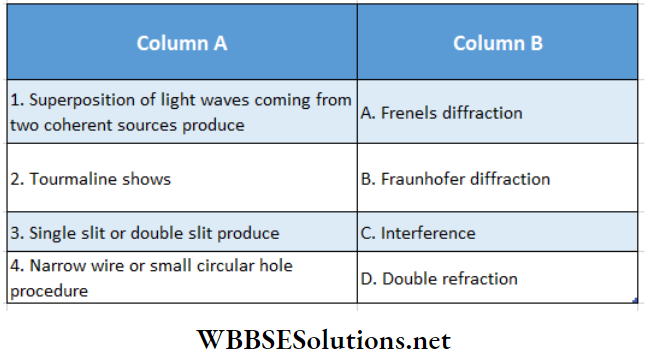
Answer: 1-C, 2-D,3- B, 4- A
Question 2. Factors on which the width of central maximum, formed due to single slit Fraunhofer diffraction, depends are to be matched.

Answer: 1-B, 2-D,3- A, 4- A

